Studio equipment
Our full range of studio equipment from all the leading equipment and software brands. Guaranteed fast delivery and low prices.
DJ equipment
Our full range of DJ equipment from all the leading equipment and software brands. Guaranteed fast delivery and low prices. Visit Juno DJ
Filter
Switch genre
Switch view
My filters
Equipment
Format
Brand
Featured
Price
Tags
Studio Equipment preorders
Welcome to our preorders page, where you can preorder vinyl & CDs due for release in the coming weeks and months.
All preorders are despatched as soon as they released, and you don't pay until they ship!- Interest:
- High to low
- Latest Additions:
- New to old
- Artist:
- A to Z
- Z to A
- Title:
- A to Z
- Z to A
- Label:
- A to Z
- Z to A
- Date:
- Old to new
- New to old
- Price:
- Low to high
- High to low
- Label rank:
- Low to high
- High to low
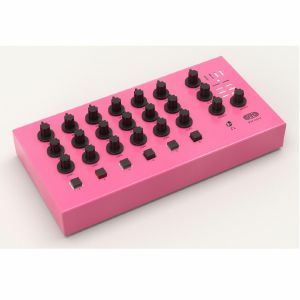
- Full analogue mixer
- 4 channels with variable gain up to +34 dB, asymmetrical soft clipping and a tilt eq
- 2 channels with Baxandall 2 bands eq and a 0/+10 dB selectable input gain
- 3:1 ratio one-knob compressor on the master bus
- Bliss hi frequency enhancer on the master bus
- Unity gain Hi Fidelity phones out. Can be used as a second master output
- Alternate output
- 24 volts internal power supply for pro audio dynamic range
- Rugged Switchcraft- 3.5 mm stereo mini-jack connectors
- Audiophile film capacitors used in the eq circuitry, low noise and low distortion op amp on the audio path, THAT Corporation- VCAs, ALPS- pots
Dimensions : 290 x 145 x 62 mm
Weight : 1338 g
This product is available for pre-order at Juno, for shipping on the release date. You won’t be charged until the order is despatched.
We'll keep you informed of your order at every stage, and let you know if the release date changes.
If the price of the item drops before it's released, you will pay the lower price, but if it increases, you'll only pay the price you see today.
If you also include in-stock items on your order, they’ll be charged and shipped within 24 hours as usual.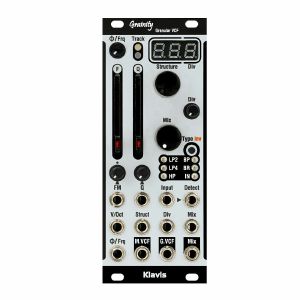
While being based on analogue filtering only, the Grainity expands and enriches the sound in creating subharmonics, harmonies, unison, flanging effects and formant filtering all at once.
The module presents two sections, the granular filter itself and a typical multimode filter, each with its own output.
A third output offers a mix of both filter paths. Numerous controls and CV allow a very wide palette of results.
What is the Grainity
Granular?
The word granular was chosen for this filter module in relation to the concept invented by the composer Yannis Xenakis, and which is described as assembling small chops of sounds - he called grains - according to a pattern.
This is exactly what the Grainity does, no more no less ... but, digital control allows doing it in ways that are decades away from what tape and scissors allowed at the time.
Technology wise ...
In the granular section, the incoming sound cycle is determined in order to step through various filtering and phase variations of itself according to predefined patterns called structures.
The controls allow alterations to the cycling phase, cycling frequency offset (tuning), structure selection and frequency division of the filters cycling. This comes in addition to the usual filter frequency and resonance controls.
What the Grainity is not
Technology wise ...
Despite relying on a microprocessor, the Grainity is not a digital audio processor. At any time, the sound remains in the analog domain and goes through analog circuits from in to out.
The digital processor does not convert or generate audio signals; it is there to control the analog circuitry and manage the interface and display.
Sound wise ...
Several digital modules offering granular processing rely on the layering of sound grains, which leads to blurry and cloudy textures.
Layering of the grains is a late addition to the concept of granular synthesis and is not a mandatory feature of the concept.
The Grainity does not use delay lines or sampling memory but is nevertheless true to the foundations of the granular synthesis concept.
The granular VCF in the Grainity is unconventional in that, most of times, it is not filtering the sound in the common expectation of removing something. Typically, the granular process adds more than it removes by expanding both the lower range, creating subharmonics, and the upper harmonic contents in multiples ways.
Dimensions
10 HP
21 mm deep
Current Draw
101 mA +12V
59 mA -12V
This product is available for pre-order at Juno, for shipping on the release date. You won’t be charged until the order is despatched.
We'll keep you informed of your order at every stage, and let you know if the release date changes.
If the price of the item drops before it's released, you will pay the lower price, but if it increases, you'll only pay the price you see today.
If you also include in-stock items on your order, they’ll be charged and shipped within 24 hours as usual.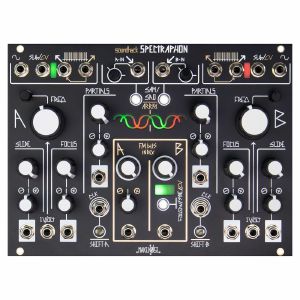
The Spectraphon is the first module to be built by Make Noise on its new digital hardware platform. This hardware, engineered by Jeff Snyder and Tony Rolando, provides more i/o at higher resolutions, and a lower noise floor than we have ever had access to in a digital module, allowing us to unleash Tom Erbe's DSP code to a previously unattainable degree.
The Spectraphon has two nearly identical sides, A and B, which oscillate in one of two ways: Spectral Amplitude Modulation (SAM), or Spectral Array Oscillation (SAO). In SAM, instead of oscillating at all times like an analogue VCO, sound at the Spectraphon's input is used to modulate the amplitude of a set of harmonics. In SAM the Spectraphon can be sequenced and frequency modulated like any VCO. At any time the current spectrum can be used to create an Array for later use in SAO mode where the Spectraphon oscillates at all times, with the spectrum at the Odd and Even harmonic outputs being drawn from those stored Arrays.
The Slide and Focus controls are mode-dependent: in SAM, they determine how the Spectraphon responds to sound at the input for Spectral AM, while in SAO, they are used to modulate the Array.
In either mode (SAM or SAO), the Partials control works as a combined amplitude and timbre gate for the Odd and Even harmonic output and the FM Bus will create high definition internal frequency modulation from the opposing side of the Spectraphon. The two sides can also interact via the internal FM Bus, the Follow and Sync modes, and by patching them together.
Width: 34hp
Power:
230mA @ +12V
55mA @ -12V
Module Depth (incl power cable): 36mm
This product is available for pre-order at Juno, for shipping on the release date. You won’t be charged until the order is despatched.
We'll keep you informed of your order at every stage, and let you know if the release date changes.
If the price of the item drops before it's released, you will pay the lower price, but if it increases, you'll only pay the price you see today.
If you also include in-stock items on your order, they’ll be charged and shipped within 24 hours as usual.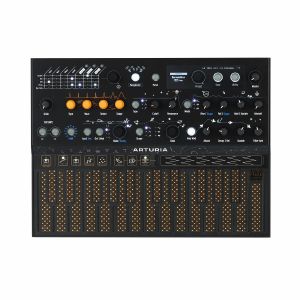
Interplanetary synth explorer
Discover the same loveable hybrid beast that sent the synth world into a spin, but primed for launch and ready for an interplanetary sonic voyage. MicroFreak Stellar features the same inspiring, bonkers sound but embellished with a unique space-age design.
Digital, wavetable, sampling, granular...
Treat yourself to only the weirdest & most wonderful paraphonic synth sounds with MicroFreak's multimode sound engine. Choose from numerous algorithms, including Wavetable, Chord, 4 new Sample & Granular engines and many more, and immediately customize your patches with 4 intuitive con-trols and real-time visual feedback.
Multi-mode analogue filter
Unlock truly unique hybrid tones by combining MicroFreak's digital sound engines with a crunchy resonant analogue filter, inspired by the classic Oberheim SEM. With low-pass, band-pass, and high-pass modes, you can make this 'Freak whisper, scream, or launch into self-oscillating orbit.
Modulation matrix
Quickly rewire MicroFreak's architecture and delve deep into complex sound design with its modulation matrix, offering up to 7 simultaneous destinations and 5 sources, including an ADSR envelope, cycling envelope, and 6-shape LFO.
Sequencing & randomization
Blur the lines between sequencing & arpeggiation and create spontaneous melodies, motifs, and rhythmic patterns on the fly. MicroFreak encourages musical exploration, expression, and evolution with its unique Spice & Dice randomization feature, ribbon controller, and 4 lanes of automation.
A unique keybed
Change the way you play and unlock fresh musical expression with MicroFreak's distinct PCB keyboard. It's flat, it's fast, and it's fit for everything from lightning-fast solos to instant arp creation; not only is it pressure sensitive, but it offers poly-aftertouch too!
What's in the box
Box content
MicroFreak Unit
Universal PSU
Registration card
2x MIDI port adapters
Instrument dimensions
Size : 12.2 x 9.2 x 2.2 inches (311 x 233 x 55mm)
Weight : 2.3 lbs. (1.02 Kg)
This product is available for pre-order at Juno, for shipping on the release date. You won’t be charged until the order is despatched.
We'll keep you informed of your order at every stage, and let you know if the release date changes.
If the price of the item drops before it's released, you will pay the lower price, but if it increases, you'll only pay the price you see today.
If you also include in-stock items on your order, they’ll be charged and shipped within 24 hours as usual.
Osmose is the new standard for musical expressivity. Use intuitive gestures to control this standalone synthesizer and upgrade your playing & production skills. Press, bend, shake, strum & more to interact with keyboards & electronic sounds in a new organic way. Whether you're a veteran keyboardist, a workflow-oriented producer, a daring sound designer, or anything in between, Osmose will take your musical journey to uncharted places.
Explore new ways to play
Behind the expressivity of Osmose lies a few natural gestures you already know well. Discover how they interact with Osmose and enhance your musicianship from the very first touch.
Design & build quality
Designed in France to stand the test of time and touring with style, Osmose is made of quality components and boasts a high repairability index.
A sound engine by Haken Audio
Made for expressivity by Haken Audio, the EaganMatrix sound engine is at home with FM, virtual analogue, and physical modeling synthesis, as well as everything in-between.
Fun to play
Easy-to-tweak presets, a playful interface, and an innovative keybed make for a fun & refreshing playing experience, for players of all levels.
Osmose's browser has been tailored to make it a hassle-free experience. It offers various filters and sub-filters based on both sound types and colours so you can find the sounds in your head quickly.
Main features:
49 Key MPE keyboard with polyphonic aftertouch
Full-size keys with 3-dimension MPE control
EaganMatrix sound engine by Haken Audio: a digital modular sandbox allowing subtractive, FM and different physical modeling synthesis
24 voices of polyphony
Assignable mod and pitch sliders
500 factory presets
128 user presets
Configuration modes: standalone synthesizer, MPE MIDI Controller, and classic MIDI Controller
Filters and sub-filters for browsing
Customisable sensitivity and velocity curves
Multi-mode MPE arpeggiator and innovative pressure glide feature
Digital stereo effects: select between reverb , mod delay, swept echo,analog echo or LPF and HPF delay
Large colour display
9 push encoders
2 Line outputs: Two 14" TS pseudo balanced line outputs
MIDI input, output, and MIDI-thru
USB MIDI
Separated 14" TRS headphone output on the front panel (with its dedicated volume knob)
2 continuous pedal inputs assignable to macro or sustain: 6.35 mm Jack
Power: External PSU with lockable connector, 12V, 1.5A, center positive
Dimensions (W x H x D): 894 x 316 x 87.5 mm / 35.2" x 12.4" x 3.4"
Weight: 8.3 kg / 18.4 lbs
Includes a software updater for new firmware and library versions
Includes a Mac/PC editor to create and edit sound
This product is available for pre-order at Juno, for shipping on the release date. You won’t be charged until the order is despatched.
We'll keep you informed of your order at every stage, and let you know if the release date changes.
If the price of the item drops before it's released, you will pay the lower price, but if it increases, you'll only pay the price you see today.
If you also include in-stock items on your order, they’ll be charged and shipped within 24 hours as usual.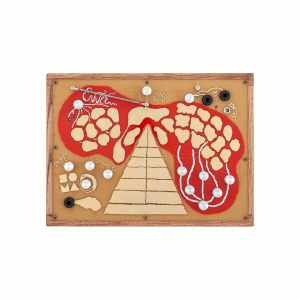
As an instrument, ENNER is a unique analogue synthesizer with the key principle being that all signals that make sound pass through and are managed by your body. Your hands become the central part of the circuitry. Touching different contact pads with different parts of your fingers and palms with different amounts of pressure, letting signals pass through your body defines the mixing, volume, timbre, feedback and other parameters of synthesis. Human skin has much more complex electric properties than we think. The skin provides not just resistance but also some capacitive properties and even nonlinear dependence of conductivity from current, its direction and time during which the current was applied. All of this affects the sound, making you the key part of the synthesis process.
All pots of ENNER are metallic and also function as inputs or outputs. Touching a pot can change not only the parameters but also patch the audio signals.
ENNER consists of:
The array of filters with fixed frequency properties (the triangle in the centre): the stereo high pass filter (HPF), the stereo bandpass filter (high mid - BPFH), the stereo bandpass filter (low mid - BPFL), the stereo lowpass filter (LPF). Stereo means that the filters have separate inputs for left and right channels as well as separate outputs. Sliding on the filters' pads with your fingers you can create a rich stereo image where each channel may have not only individual volume properties but also timbral ones. The outputs of the filters are mixed together and connected to the main output. Also in the triangle, you have a stereo direct input (DIR) that lets you bypass the filters.
The modulated stereo delay. The input of the delay is the two pads on the top of the triangle (DLY blue). The output of the delay is mixed with filter output and connected to the main output. Also, you have delay output connected to the pads placed on the left and right sides from the top of the triangle (DLY orange) that lets you create feedback and other interesting effects. The delay has two separate lines (left and right) with individual TIME controls (BPEMR pots), common FEEDBACK and the common pot that defines the amount of self-modulation (BIZZARE). The BPEMR pots are also touch inputs for delay time modulation.
On the right side of ENNER, there is a five-voice synthesizer with individual adjustment of frequency for each voice (TUNE knobs) with the possibility to change the pitch of all voices simultaneously (PITCH knob). TUNE knobs are also the outputs of the voices, so by touching them you can patch the voices to the filter's inputs. The synthesizer has separate output pads for each voice (pads OUT 1-5), individual modulation inputs (MOD 1-5) and ring modulation outputs (the RING 12, 23, 34 numbers indicate which voices are sources for the ring modulation). Connecting MOD and OUT pads of one voice with your fingers will pitch it up. The fifth voice has an additional modulation pad MOD 5- which can shift the pitch of the fifth voice down (connect it to +12 pad or any pad that has some positive signal including the output of the fifth voice).
On the left side of ENNER, there is the second synth that has one master generator, the output of which is divided six times by two with individual outputs for each stage of division (PULSE 1-6). This synth is aimed at creating rhythmical clicks, basses and octave tones. The frequency of the master generator is defined by the TEMPO knob. The output pads &1,2,3 are logical multiplications of different PULSE outputs giving additional and more complex rhythm combinations.
ENNER is also an electro-acoustic noise instrument. It has a piezo pickup attached to the front panel that captures sound from the casing itself. There is metallic spring and you can attach rubber bands to the panel to create various acoustic sounds. The piezo mic can capture clicks and scratches you make with your fingers, and it also allows you to create filtered feedback. Not only that, it can even capture your voice singing over the panel! To get sound from the piezo you have to connect the PIEZO OUT pad with some filters or delay inputs. Applying filters and delay on the piezo out while the panel works as a mic, catching the audio signal from the speakers connected to the ENNER output lets you create very cool acoustic feedback-based effects. PIEZO GAIN adjusts the piezo sensitivity.
The bottom of the triangle (NOISE pad) is the output of static pink noise.
External in (EXT socket and EXT pad) lets you send an external audio signal to ENNER and process it through the array of filters, delay and other ENNER stuff.
All of these features make ENNER a simple yet powerful kit of sound sources and FX that give you a rich and diverse sound palette with many possible playing techniques that you can change very fast as there is no other control over the sound other than your touches.
Specs
Array of filters
Pads DIR - direct input (no filters)
Pads HPF - highpass filter in
Pads BPFH - bandpass filter high mid in
Pads BPFL - bandpass filter low mid in
Pads LPF - lowpass filter in
(L - left channel, R - right channel)
Pink noise generator
NOISE - noise output
Delay
Pads DLY(blue) - delay in
Pads DLY(orange) - delay out
(L - left channel, R - right channel)
Pots BPEMR - delay time (L and R) also time modulation inputs
The UROBOROS pot - feedback (both channels)
Pot BIZZARE - delay self-modulation
Piezo
Pad PIEZO OUT - the output
Pot PIEZO GAIN - piezo amplification (also piezo output)
The five-voice synth
Pads OUT 1-5 - outputs of the voices
Pads MOD 1-5 - modulation inputs of the voices (try to connect them with OUT)
Pads RING 12, 23, 34 - outputs of ring modulators that multiply outputs of different voices
Pad MOD 5- - an additional modulation input for the fifth voice (try to connect it with +12)
Pots TUNE 1-5 - frequency of the voices (also voices outputs)
Pot PITCH - transposing all voices at once.
Rhythm\Bass synth
Pads PULSE 1-6 - output of binary dividers
Pads &1, 2, 3 - additional outputs that are logical AND of different PULSE outputs.
Pot TEMPO - the frequency of the source generator
External
Socket EXT - external in
Pad EXT - connected to EXT socket tip
Power
+12V center + 0.2A. ENNER requires a good stabilized and filtered PSU. We recommend contemporary switching mode PSUs with a wide input range. The PSU is included.
Grounding
In order that when playing on ENNER there would be no hum from the electricity grid interferences, the device must be properly grounded! A normal grounding connection at the electric socket, which is carried through the power cord to your audio equipment to which the ENNER is connected, is sufficient.
What's in the kit:
ENNER
12V center plus PSU
Several rubber bands
This product is available for pre-order at Juno, for shipping on the release date. You won’t be charged until the order is despatched.
We'll keep you informed of your order at every stage, and let you know if the release date changes.
If the price of the item drops before it's released, you will pay the lower price, but if it increases, you'll only pay the price you see today.
If you also include in-stock items on your order, they’ll be charged and shipped within 24 hours as usual.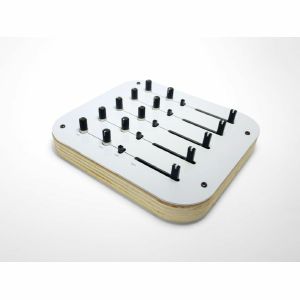
OVUM is designed for exploring pure tones, drones, and microtonal sound textures. Five independently controlled triangle-core oscillators give you five lush voices to layer and evolve. Each voice has a separate control for volume, pitch, and tone, and can be switched between a bright square wave and a crisp triangle wave.
OVUM is hand-built from 100% analog circuitry, with no digital components, screens, quantization, or key-combinations to memorize - everything is immediate and at your fingertips.
OVUM is enclosed in a beautiful and sturdy wood and aluminum case that feels as good in your hands as it looks on your tabletop.
OVUM has a USB-C port for power, and a single 3.5mm audio output jack for headphones or line-out to connect to an amplifier, audio interface, or effects.
To reduce waste, by default OVUM comes with just the instrument and a USB to USB-C power cable. If you don't have a spare USB power supply, they can be added to your purchase at checkout. OVUM is portable, but does not contain a battery. It can be powered by any USB powerbank.
This product is available for pre-order at Juno, for shipping on the release date. You won’t be charged until the order is despatched.
We'll keep you informed of your order at every stage, and let you know if the release date changes.
If the price of the item drops before it's released, you will pay the lower price, but if it increases, you'll only pay the price you see today.
If you also include in-stock items on your order, they’ll be charged and shipped within 24 hours as usual.
Furthermore the synth offers full MIDI/USB control and the ability to store 128 presets per bank across 10 banks. Sophisticated microtuning with a support of ODDSound MTS-ESP and a signature arpeggiator integrates this classic synth concept seamlessly into the future of your modern studio needs.
This product is available for pre-order at Juno, for shipping on the release date. You won’t be charged until the order is despatched.
We'll keep you informed of your order at every stage, and let you know if the release date changes.
If the price of the item drops before it's released, you will pay the lower price, but if it increases, you'll only pay the price you see today.
If you also include in-stock items on your order, they’ll be charged and shipped within 24 hours as usual.
The cherry on top is the digitally-controlled chorusing that applies subtle pitch shifting to the second oscillator. This gives a sound that echoes back to the Juno chorus circuit but with a unique twist.
Dimensions
14 HP
25 mm deep
Current Draw
100 mA +12V
35 mA -12V
This product is available for pre-order at Juno, for shipping on the release date. You won’t be charged until the order is despatched.
We'll keep you informed of your order at every stage, and let you know if the release date changes.
If the price of the item drops before it's released, you will pay the lower price, but if it increases, you'll only pay the price you see today.
If you also include in-stock items on your order, they’ll be charged and shipped within 24 hours as usual.
Seasoning is crucial for cooking. It is a process that enhances the flavors, glues the ingredients together, and even adds some unexpected kick.
From a gentle refining touch to a shovelful of spice, CUNSA is the perfect seasoning tool for your patches. It can sweeten a sour lead or beef up an insipid bass line, and anything in between.
And, just like a good oil, you can even taste it by itself!
CUNSA is a quadruple analog pingable multimode resonant filter, saturator, mixer, and oscillator.
It is Frap Tools' sound seasoning tool: it can gently even a patch, applying a final touch, or it can set it on fire with a ridiculous amount of spice. It's up to you and your cooking style!
It consists of four multimode resonant filters with a custom saturation and feedback control that you can use independently or in various combinations and roles thanks to a series of seminormalizations.
Four Analogue Resonant Multimode Filters
CUNSA features four state-variable filters that can be used independently or linked and mixed. Each filter provides three behaviors simultaneously: lowpass, bandpass, and highpass. Each behavior has a 12 dB/oct slope, except for the lowpass, which can be either 12 or 24 dB/oct.
Unique 'Character' Circuit for Feedback and Distortion
CUNSA handles feedback and gain staging with extreme control and versatility. Besides the usual Q control that emphasizes the cutoff frequency, the Character circuit defines the amount of soft clipping when the filter overloads. High clipping guarantees a controlled behavior with fat tone and pure resonance, while low or no clipping lets the signal saturate the filter stages and make it scream.
V/oct Tracking and Quadruple Oscillator
Each filter responds to the V/oct signal with excellent tracking. It is thus possible to move the cutoff frequency along with the main melody or make CUNSA resonate with no input and transform it into a multiple oscillator. The V/oct inputs are seminormalled so you can control more filters with the same CV. Easy chords stabs!
Ping and Ring
CUNSA is ideal for percussive and organic tones. The Ping circuit offers a behavior similar to the BRENSO but AC-coupled. Instead of shooting the frequency to the moon with any trig, CUNSA gently responds to different incoming gates with a selectable decay curve. The Ping circuit can thus create natural decay sounds when fed with trigs or smoother envelopes with any other voltage, like a linear integrator with a custom decay.
Besides this, you can also feed the filter's audio input with trigs and make it ring at high Q settings.
Linked or Individual Filtering
The four filters can work independently or arranged in groups through seminormalled inputs and sum outputs. CUNSA can thus be a 4×1, 2×2, or a massive 1×4 filter. Even odd configurations are possible, like 1+2+1 or 3+1. Mono, stereo, or quadraphonic audio is at your fingertips.
Filter and Combo Behaviour
When the filter behavior is set to COMBINED, every control of the cutoff frequency also affects the input VCA, reducing the signal amplitude and saturation as it approaches the lowest range. It can make organic decays with the ping circuit or tame the low range at high Q and Character settings.
Four Seminormalizations for Group Use
Four inputs have a cascaded seminormalization: audio inputs, VCA CV, V/oct, and Ping. Every signal patched to a filter will thus feed also those at its right, making simultaneous use even simpler. To remove a seminormalization, simply patch a dummy cable to the corresponding input.
Analog Mixing Stage and Group Outputs
Every filter output can be routed to an analogue mix bus that sums the four filters and outputs them in three combinations: all, 1+2, and 3+4. These outputs allow for versatile audio processing. Just like we did with FUMANA, we added a gentle shelving EQ for the higher frequencies of the All output to provide additional timbral variety.
CV Inputs with Attenuators
Besides the seminormalled inputs, every filter features additional CV inputs for cutoff frequency, Q, and Character, each with a dedicated attenuverter.
This product is available for pre-order at Juno, for shipping on the release date. You won’t be charged until the order is despatched.
We'll keep you informed of your order at every stage, and let you know if the release date changes.
If the price of the item drops before it's released, you will pay the lower price, but if it increases, you'll only pay the price you see today.
If you also include in-stock items on your order, they’ll be charged and shipped within 24 hours as usual.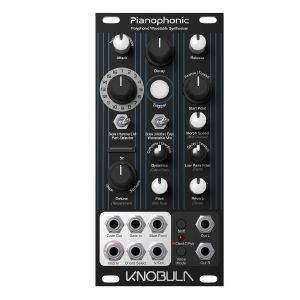
Taking its inspiration from the wavetable/sampler keyboards of the 90s, Pianophonic revisits a lean and mean approach to digital sound creation but instead with 24bit 48Khz quality and fingertip control of the parameters that really matter.
With a built in SD card and an online re-synthesise utility, allowing users to create their own sound banks, the possibilities for sound exploration are limitless.
This product is available for pre-order at Juno, for shipping on the release date. You won’t be charged until the order is despatched.
We'll keep you informed of your order at every stage, and let you know if the release date changes.
If the price of the item drops before it's released, you will pay the lower price, but if it increases, you'll only pay the price you see today.
If you also include in-stock items on your order, they’ll be charged and shipped within 24 hours as usual.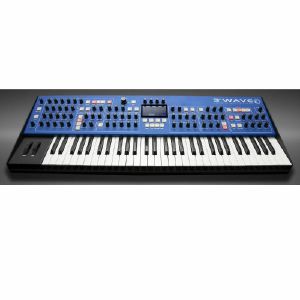
Each of its 3 oscillators per voice can be:
A classic PPG-era wavetable
A high-resolution complex wavetable
An analogue-modelled waveform
Create up to 64 custom wavetables of your own using the built-in Wavemaker. With sample-to-wavetable capability, you can connect an audio source to the audio input and generate a wavetable at the touch of a button.
Classic legacy; modern sound
While the 3rd Wave has roots in the classic digital wavetable synths of the past, it takes that concept into the 21st century with a lush, expansive sound that's a product of its expanded wavetables and warm, organic-sounding analogue filters
It boasts not only a punchy, Dave Rossum-designed 2140 analogue low-pass filter with variable saturation, but a second, SEM-style state-variable filter (low-pass, high-pass, notch, and band-pass) for additional tone-sculpting. Run both filters in series for harmonically complex textures.
4-part; multi-timbral
With 24-voices, the 3rd Wave has enough power for the most note-intensive performances.
And that polyphony really comes into play with its ability to layer up to 4 independent parts or split zones - each with a completely different sound, sequence, and dual effect.
Each stereo part has independent panning, volume, and a dedicated stereo physical output.
Modulation Matrix
The secret weapon of any synth is its mod matrix, and the 3rd Wave doesn't disappoint.
With 16 assignable slots, 12 additional fixed-source slots, 27 sources, and 114 destinations, it has the flexibility of a modular.
And all of this power is per multipart. That means up to 4 independent layers of sound, each with its own mod matrix.
Sequence notes; songs & params
The 3rd Wave's sequencer is an inspiring tool for both composers and sound designers because it is pattern-based and can sequence notes, songs, and parameter changes.
For composing and performing, enter notes and chords in real time with or without quantization for maximum groove and arrange up to 24 patterns of up to 32 measures in length into songs just as easily.
Specs
Sound Engine
3 High-resolution Digital Oscillators Per Voice
64 total user wavetable positions with 48 wavetables that contain 64 waveforms per table (32 legacy PPG waves with room for another 16 of this type)
32 original 8 bit wavetables from the PPG 2 series instruments with room for 16 more user created 8 bit wavetables
7 high-resolution modelled analogue waveforms (sine, saw, triangle, supersaw, pulse, white noise, pink noise)
VCO sync
Linear FM
6-stage wave envelope per oscillator with variable time and position that can be looped
Optional wave flow section that allows for no wavetable as well as no waveform interpolation
Upper wavetable mode as with the original PPG 2 series
Unison mode and chord mode with variable voice count
1 Analogue Low-pass Filter
Dave Rossum designed, classic, 2140 low-pass resonant filter
24 db per octave slope
variable saturation amount
optional resonance compensation
1 State-Variable Filter
12 db per octave slope
Continuously variable between low-pass, notch, and high-pass, operation with optional band-pass mode
4 ADSR+ Delay Envelopes
Filter, Amplifier, plus 2 additional envelopes switchable between exponential and vintage PPG-style response
Freely assignable to multiple modulation destinations
4 Low-Frequency Oscillators
Triangle, sawtooth, reverse sawtooth, square, pulse 1, pulse 2, pulse 3, and random (S&H)
Variable delay
Note reset
Syncable to master clock BPM
2 Digital Effects
BBD, stereo delay, tape delay, chorus, phaser, flanger, distortion pedal, rotating speaker, ring mod, room reverb, hall reverb, super plate reverb - most modelled on famous hardware devices
Syncable to master clock BPM
Parameters modulatable via mod matrix
Wavemaker Tool: Built-In Custom Wavetable Maker
"Sample-to-wave" functionality. Connect an audio source to the 3rd Wave's Audio In port, press "Make Waves" and the synth samples the audio to create a custom wavetable
Samples to convert can also be brought in as a 96 kHz wav file through USB
Store up to 32 custom wavetables
64 waveforms per wavetable
Accepts pitched or un-pitched material as input
96 kHz sampling rate
16-bit resolution
1024 cycles per waveform, converted automatically to cover entire keyboard range
Flexible wave-sampling length
Imports Serum™ wavetables
Sequencer: Performs both Note and Parameter Sequencing
4 parts per sequence
24 sequences per preset
Up to 32 measures per sequence
Variable quantization resolution per sequence (32nd, 16th, 8th, quarter, half, whole note, or quantization off), that is settable in real time
Variable swing
Arpeggiator: 1 Arp per Multi-part
Up, down, up/down, and assign modes
Variable range (1, 2, or 3 octaves)
Mod Matrix: 16-slot Modulation Matrix Per Multi-Part
16 slot modulation matrix with 27 mod sources and 114 mod destinations
12 additional fixed-source mod paths
Modulation assignment buttons enable quick and easy modulation routing
Mod Matrix runs at audio rates
Sequencer can record and play mod parameter changes in real time
Controls
77 knobs and 39 buttons enable deep, comprehensive editing with minimal menu diving
Pitch and Mod Wheels
Full-sized, five-octave, semi-weighted, premium Fatar keyboard with velocity and aftertouch
Programs
500 factory programs. User rewritable
In/out
4 Stereo outputs (2x 1/4? phone jack per part)
Headphone out (stereo 1/4? phone jack)
MIDI In, MIDI Out, and MIDI Thru
USB port for bidirectional MIDI communication
Audio Input for creating user wavetables from external audio source (1/4? phone jack)
Audio Input can also route audio through the filters, output chain, and effects
Sustain/footswitch input
Volume pedal input
Expression pedal input
Power
1 universal IEC AC power inlet for internal power supply
Operates worldwide on voltages between 100-240v, 50-60 Hz, 65 watts maximum power consumption
Dimensions
Shipping Box Dimensions: 44 x 20 x 13 inches, 35 lbs
Synth Dimensions: 38.5 x 14.25 x 5 inches, 27 lbs
This product is available for pre-order at Juno, for shipping on the release date. You won’t be charged until the order is despatched.
We'll keep you informed of your order at every stage, and let you know if the release date changes.
If the price of the item drops before it's released, you will pay the lower price, but if it increases, you'll only pay the price you see today.
If you also include in-stock items on your order, they’ll be charged and shipped within 24 hours as usual.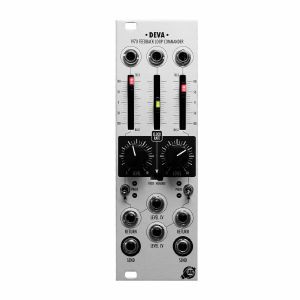
Technical details
Eurorack synth compatible
8hp, skiff friendly
Power drawn from Timiszoara: +60mA/ -50mA
Reverse power protection
This product is available for pre-order at Juno, for shipping on the release date. You won’t be charged until the order is despatched.
We'll keep you informed of your order at every stage, and let you know if the release date changes.
If the price of the item drops before it's released, you will pay the lower price, but if it increases, you'll only pay the price you see today.
If you also include in-stock items on your order, they’ll be charged and shipped within 24 hours as usual.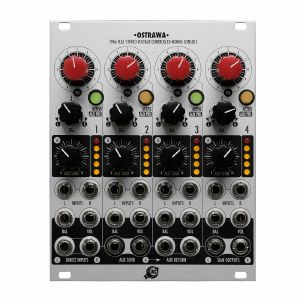
Xaoc Devices have carefully crafted Ostrawa's voltage control response to achieve what we believe to be the optimal user experience found in a Eurorack mixer. The design features an elaborate control circuit that combines the internal voltages generated by the panel potentiometers with external CV over volume and stereo balance. The result is a natural attenuator response that constrains VCA gain to a usable range while minimizing distortion.
Ostrawa is a sister module to Xaoc devices Praga. It features a very similar response characteristics and similar layout of controls with some functional differences resulting from stereo inputs and limited panel space. Multiple Ostrawa and Praga units may be chained for a custom configurable mixing system. An expander called Bohumin is also available.
Technical details
Eurorack synth compatible
20hp, skiff friendly
Current draw: +180mA/-150mA
Reverse power protection
This product is available for pre-order at Juno, for shipping on the release date. You won’t be charged until the order is despatched.
We'll keep you informed of your order at every stage, and let you know if the release date changes.
If the price of the item drops before it's released, you will pay the lower price, but if it increases, you'll only pay the price you see today.
If you also include in-stock items on your order, they’ll be charged and shipped within 24 hours as usual.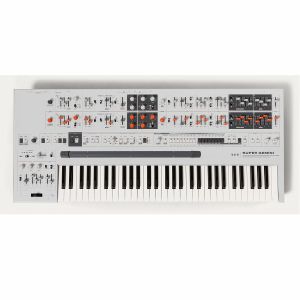
Stacked with up to 20 voices of polyphony, each performance is an entire spectrum of sonic opportunity in which voices and timbral layers can be split, dualled, sequenced all at the touch of a single control. Unique spectrally rich digital hardware oscillators, decorated with expansive tonal features such as wave morphing, cross & ring modulation, bi-directional sync and more, all feed into an all-analog signal path inspired by the classic vintage instruments of our past.
Matching sonic innovation with tactility, the Super Gemini is equipped with a 61-note semi-weighted keybed with polyphonic aftertouch, in addition to a custom engineered ribbon sensor for individual note articulation and a gestural way to explore your sound. With 256 performance and patch slots, 64 interchangeable waveforms and 16 sequences, you can safely store and edit your sounds without concern.
As the second synth in the 'Super' series, the Gemini represents a quantum leap in UDO's technology - building on the acclaimed rich sound pioneered by George Hearn and the Super 6. Adopting a true-stereo Binaural signal path with dual FPGAs and twin effects processors, Gemini will take you on an adventure of spectral dynamics, of glittering frequency and shattering subharmonics, of comfort and discord, expectations and surprises.
DUALITY IN CONTROL
Equipped with dual synth-control levels, the Super Gemini gifts you with comprehensive and immediate control over multiple patches/timbral layers, calling out for you to tweak, mold and transform your performances in an unprecedented real-time form. This is a synth that opens new heights of powerful and immediate play.
THE POWER OF PLAY
With a total of 20 voices, the option to split and stack patches, each with its own individual arpeggio or sequence, and an uncompromisingly powerful sound engine, the Super Gemini allows you to push sonic boundaries and to explore the acclaimed UDO sound to the fullest.
INSPIRED BY THE CLASSICS,
BUILT FOR TODAY
Super Gemini fuses a state-of-the-art FPGA digital architecture with archetypal voltage-controlled synthesizer technology. This harmonious marriage of old and new encompasses all that is great from the era of classic analog polyphonic synthesizers, yet in an unparalleled form factor which is immensely powerful, flexible, and reliable.
BINAURAL SYNTHESIS
Employing a true-stereo signal path, the Super Gemini twins its 20 voices to form 10 'super voices'. As a result, the left and right channels, and each of your ears, are assigned a complete synthesizer voice. This empowers UDO's championed warm analogue tone, and enables you to create extremely dynamic spatial sounds.
UNLIMITED EXPRESSION
Featuring a custom-designed ribbon controller and a 61-note semi-weighted keyboard with polyphonic aftertouch, the Super Gemini will enhance your musicianship from the first touch, opening up new ways for you to explore and express your sound.
TRUE NO-COMPROMISE BUILD QUALITY
Forged entirely from aluminium and steel, the Super Gemini is undeniably robust. Equipped with an array of superior quality mechanical controls, the Super Gemini is engineered for reliability and service. As a loyal workmate and companion, this instrument is designed to stand the test of time.
This product is available for pre-order at Juno, for shipping on the release date. You won’t be charged until the order is despatched.
We'll keep you informed of your order at every stage, and let you know if the release date changes.
If the price of the item drops before it's released, you will pay the lower price, but if it increases, you'll only pay the price you see today.
If you also include in-stock items on your order, they’ll be charged and shipped within 24 hours as usual.
2 independent FM voices each with user-controllable waveform, modulation envelope and LFO, integrated with a 16-step generative sequencer.
Voices
2 independent 8-bit FM voices
2-operator FM (for old-school Prince Of Persia vibes!)
Multi-mode FM ratios - quantised, free-multiple, independent
Multiple operator waveforms for carrier & modulator - Sine, Triangle, Overdriven triangle, Saw, Square, Noise, Off
Attack/Decay modulation envelope per voice
LFO per voice with multiple waveforms and configurable destination: modulation envelope (attack, decay or depth), FM ratio, note length
Sequencer
2/1.5 track polymetric sequencer with up to 16 steps per track (Both tracks use same note sequence but can have different step-counts for poly-metric rhythms)
Multiple generative algorithms - (semi)random notes, (semi)random runs, arpeggio, drone
Sequence mutates/evolves at user-defined rate & note-density
Selectable tonic, octave & scale - Ionian (Major), Minor (Dorian), Pentatonic, Phrygian (GOA!), Octaves, Fifths
Tap-tempo control
Sync input & output (Korg Volca compatible)
16-step parameter-lock recording of synth parameters (track 1 only)
Hardware
Mono audio output (16KHz 14-bit DAC)
Sync input / output (0-5V rising-edge)
Powered by an Arduino Nano V3
112mm (w) x 100mm (d) x 40mm (h)
7-12V DC or micro USB powered
Specifications and Architecture
Voice Architecture
Voice 1
Voice 2
Carrier - 8-bit digital oscillator
Octave 0-7
Waveform - Sine, Triangle, Overdriven Triangle, Saw, Square, Noise, Off
Carrier - 8-bit digital oscillator
Octave 0-7
Waveform - Sine, Triangle, Overdriven Triangle, Saw, Square, Noise, Off
Modulator
FM Ratio
FM Ratio Mode - quantised, high-multiple, low-multiple, fixed
Waveform - Sine, Triangle, Overdriven Triangle, Saw, Square, Noise, Off
Modulator
FM Ratio
FM Ratio Mode - quantised, high-multiple, low-multiple, fixed
Waveform - Sine, Triangle, Overdriven Triangle, Saw, Square, Noise, Off
Modulation Envelope
Depth
Attack time
Decay time
Modulation Envelope
Depth
Attack time
Decay time
LFO
Depth
Rate
Waveform - Sine, Triangle, Overdriven Triangle, Saw, Square, Noise, Off
LFO
Depth
Rate
Waveform - Sine, Triangle, Overdriven Triangle, Saw, Square, Noise, Off
Parameter Locks
Per-step parameter locks:
Note length
LFO depth
FM Ratio
Modulation envelope attack, decay & depth
Parameter locks apply to track 1, but are recorded into the track with the longest sequence length. For example, if Track 1 has 3 steps and track 2 has 16 steps, you will record a 16-step parameter-lock sequence which is applied to track 1
Sequencer Architecture
Track 1: Sequence Length, Current Step
Track 2: Sequence Length, Current Step
Shared: Sequence Notes, Sequence Mutation Rate, Sequence Note Density, Sync pulse clock division (1-4 steps per pulse)
Specifications
Synthesis:2-operator FM, 8-bit digital oscillators
Polyphony: 2 bi-timbral voices
Sequencer: 2/1.5 track 16 step polymetric sequencer
Modulation: Attack/decay envelope per channel, Multi-waveform LFO per channel, Parameter locking per step (voice 1 only)
I/O:
Mono audio out
Sync in / out
DC power 9-12v
Micro USB (power and firmware update)
Eurorack power (with modification)
External Sync Input:
3.5mm mono jack
0-5V rising edge sync pulse
1-4 steps per pulse (user configurable)
External Sync Output:
3.5mm mono jack
0-5V rising edge sync pulse (15ms)
1 pulse output per 1-4 steps (user configurable)
Signal Output: 3.5mm mono jack, Signal output 14-bit 16384Hz DAC
Microprocessor: Arduino Nano V3 (ATMEGA328P)
Power supply:
Micro USB
9-12VDC 2.1mm Positive tip
Can be adapted for +12V eurorack power
Display: 8 x 8 LED matrix
Power consumption: 300mA @ 12VDC
Dimensions: 111mm (w) (~22HP) x 100mm (d) x 40mm (h)
This product is available for pre-order at Juno, for shipping on the release date. You won’t be charged until the order is despatched.
We'll keep you informed of your order at every stage, and let you know if the release date changes.
If the price of the item drops before it's released, you will pay the lower price, but if it increases, you'll only pay the price you see today.
If you also include in-stock items on your order, they’ll be charged and shipped within 24 hours as usual.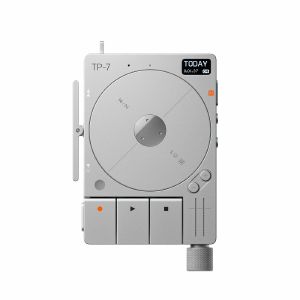
The ultra-portable audio recorder. Record and listen back using the internal mic and speaker, or use any number of the 3x two-way jacks for external mics, headsets or other signal sources. Multiple connectivity options include USB-C, MFi and Bluetooth. Instant voice-to-text transcription available via the IOS app. Included in the box: 6.35 mm jack adapter, textile USB-C cable, user guide and reusable plastic storage box.
Intuitive muscle reflex control.
TP-7 fits perfectly in the palm of your hand and lets your fingers naturally adopt the controls. The index finger triggers fast forward and the middle finger rewinds. Your thumb records a memo, the pinky selects the mode. It's a genuinely rewarding experience.
Tape reel sensation.
The centre piece of the TP-7 is the motorized tape reel. A delicately engineered brushed motor with ball bearings, and a highly sensitive hall sensor that lets you virtually grab your recording. the reel is also used for scrubbing, to pause, menu navigation and as gentle visual feedback during playback and recording.
The rocker.
The side-mounted rocker allows you to quickly scrub through your audio.
just press on the top edge to fast forward, and down to rewind. watch the wheel spin around and hear your tracks scrub in 'hyperspeed'.
Transcription hell turned into transcription heaven.
We've all experienced the process of transcribing recorded speech to text by hand. A key feature of the TP-7 is its ability to streamline the process of turning audio into text. simply connect your phone to TP-7 via BLE or USB, open the TP-7 app and press transcribe. Job done!
(* Additional languages, text-to-audio edit and other useful features will be added over time.)
Off the record.
Picture yourself in an interview situation. The reel on the TP-7 is spinning slowly, the bright red record lamp is lit. Both the reel and the lamp indicates that a recording is taking place. The interview is going quite well. The situation gets heated, you're suddenly asked some personal questions. In that moment, you gently place a finger on the reel and pause the recording, allowing you to continue the interview 'off the record'.
The importance of zero friction.
(or how to remove steps from thought to action.)
Let's compare TP-7 to the most common recorder today - the smartphone:
Once you've turned on and unlocked your phone, found the recording app and started recording, you've probably forgotten whatever you had in mind. When recording on TP-7: press the memo button and start talking.
Inputs, outputs and 20 years of ideas.
TP-7 features three stereo two-way jacks to be used as either inputs or outputs, for connecting external mics, headphones, studio monitors, or any other audio equipment like OP-1 field or TX-6, recording with all 6 stereo channels. Use USB-C for multi-channel audio interface, MIDI, data transfer and charging, and BLE and MFi for wireless connectivity. TP-7 also includes a 6.35 mm to 3.5 mm jack adapter. Add to that 128 GB of internal storage and you can preserve 5 minutes of ideas a day for 20 years..
Applications.
Interview
Let you, and your subject, focus on the job at hand. When conducting interviews, TP-7's discreet size and dedicated function makes for an unobtrusive recording device.
Podcast
Whether you're in the studio or out in the field, TP-7's high quality audio is perfect for podcast recording. Connect up to 3 external mics, or use the internal mic in a pinch. Keep an eye on your levels with the VU meter and headphones.
Voice memos
Think out loud, tape does the rest. Let TP-7 capture your thoughts, then convert them into accurate text using the TP-7 app. For professionals, and avid thinkers and writers.
Field recording
Inspiration can strike when you least expect it. With an internal mic, 3x inputs, and a 7 hr rechargeable battery, you can use tape to record samples and demos on the go. Never lose an idea again.
Live performance
Use TP-7 in a live performance or recording scenario. Track all the instruments in your studio, or record your live set when performing. You can even use TP-7 as turntables and TX-6 to mix.
The field system.
TP-7 is part of Teenage Engineering's ultra-portable sound recording and performance system. All battery-powered, rechargeable via USB-C and with full interconnectivity (MIDI and high resolution audio). Compatible with iOS, macOS, and windows it's the most powerful, highest quality, portable system in the world 'as we know it'.
TP-7 specifications
Highlights
3x stereo two-way jack input/output/headset connectors
1x stereo headphones connector with 3.5 to 6.35 mm jack adapter
Internal microphone and speaker
Motorised 'tape reel'
128 GB internal storage
24-bit/96 kHz usb audio interface
Bluetooth low energy
Rechargeable battery
7 hr battery life
64x32 pixel monochrome display
LED VU meters
Companion transcription app
Dimensions and weight
96 mm x 68 mm x 16 mm
170 g / 5.6 oz
Electrical characteristics
Two-way jacks (3.5 mm TRRS)
Stereo input:
Input impedance 9.5 kOhm
Analogue gain 0 - 42 dB
Max level 8 dBu (2 Vrms)
SNR 105 dBA
Headset:
Max level out 2 dBu (1 Vrms)
SNR 110 dBA
Microphone SNR 98 dBA
Headphone output (6.35 mm TRS)
Max level 8 dBu (2 Vrms)
SNR 120 dBA
This product is available for pre-order at Juno, for shipping on the release date. You won’t be charged until the order is despatched.
We'll keep you informed of your order at every stage, and let you know if the release date changes.
If the price of the item drops before it's released, you will pay the lower price, but if it increases, you'll only pay the price you see today.
If you also include in-stock items on your order, they’ll be charged and shipped within 24 hours as usual.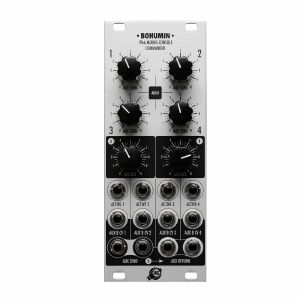
Technical details
10hp, skiff friendly
Power drawn from Ostrawa: +50mA/-40mA
This product is available for pre-order at Juno, for shipping on the release date. You won’t be charged until the order is despatched.
We'll keep you informed of your order at every stage, and let you know if the release date changes.
If the price of the item drops before it's released, you will pay the lower price, but if it increases, you'll only pay the price you see today.
If you also include in-stock items on your order, they’ll be charged and shipped within 24 hours as usual.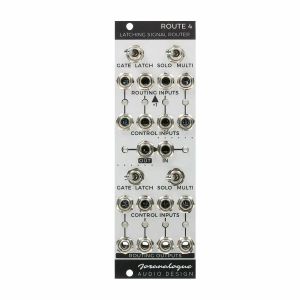
The module's top section is a 4-to-1 router. Any of the four signal inputs may be selected to be mixed into the section's output, as determined by the control inputs.
Control can either be gate or latch driveniin the latter case, the signal inputs are toggled on and off by received trigger pulses. Meanwhile, the solo/multi switch determines whether the inputs are exclusive, or if multiple may be active at the same time.
With each input socket biased by a +1 V precision voltage source when left unused, gate or trigger controlled transposition of pitch sequences becomes a breeze.
On the bottom, the 1-to-4 router provides the same feature set, with a single input being routed to up to four outputs and normalisation between the sections adding some patching convenience.
All signal paths are designed for use with any Eurorack signals, whether they be control voltages, audio or gate streams. Visual feedback is provided by 10 responsive LEDs, continually displaying the status of the routers.
With Route 4, an 8 HP super-flexible analogue mixing and routing powerhouse has arrived to fuel your patching imagination. The ability to redirect signals within a modular system on the fly, with an unparalleled level of control, is sure to excite even the most seasoned patcher.
8 HP | +12: 35 mA, -12: 20 mA
This product is available for pre-order at Juno, for shipping on the release date. You won’t be charged until the order is despatched.
We'll keep you informed of your order at every stage, and let you know if the release date changes.
If the price of the item drops before it's released, you will pay the lower price, but if it increases, you'll only pay the price you see today.
If you also include in-stock items on your order, they’ll be charged and shipped within 24 hours as usual.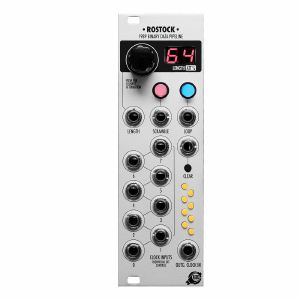
Technical details
Eurorack synth compatible
8hp, skiff friendly
Current draw: +70mA/-40mA
Reverse power protection
This product is available for pre-order at Juno, for shipping on the release date. You won’t be charged until the order is despatched.
We'll keep you informed of your order at every stage, and let you know if the release date changes.
If the price of the item drops before it's released, you will pay the lower price, but if it increases, you'll only pay the price you see today.
If you also include in-stock items on your order, they’ll be charged and shipped within 24 hours as usual.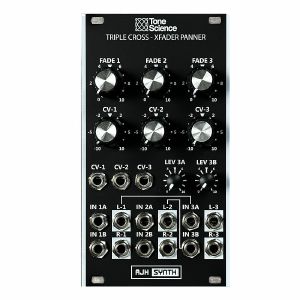
It features three independant cross fader and panner channels, and it can be used with both audio and CV signals. Each of the channels can be configured in one of four different ways:
1) One In, One out Linear VCA
2) Two in, One out crossfader
3) One in, Two out panner,
4) Two in, Two out cross fader & reversing panner combined.
Audio rate modulation can also be used on the CV inputs to create Ring modulation and Cross modulation type sounds. Each channel has a dedicated Fade control, CV input, and CV Level attenuverter. These can be used together to bias incoming CV signals.
The L1 and L2 outputs from channels 1 and 2 are normalised to channel 3's inputs, which also have their own level controls to balance incoming signals. This allows very interesting, complex fading and panning between four different input sources, to either Mono or Stereo outputs..
The Triple Cross is very versatile, yet relatively simple to understand and use. However, as they say "knowledge is power", so do spend a little time reading about how to configure the channels in the four different modes, and how to combine all three channels together to create a super-powerful Four to Two to One cross fader.
Each of the three channels can be configured in four different ways, and all three can be used simultaneously. They do not all have to be in the same mode, so we could for example use channel 1 as a cross fader, channel 2 as a Panner for completely different signals, and channel 3 as a Linear VCA, again for different signals.
Specifications
Effective CV Range for CV-1, CV-2 and CV-3 is 0 to +5V with attenuverter fully clockwise or 0 to -5V with attenuverter fully anticlockwise.
Maximum permissible CV Range for CV-1, CV-2 and CV-3 is -12 to +12V
IN 1A to IN 3B Input levels -5V to +5V, levels up to +/-10V are possible however some clipping may occur.
Module Width: 14hp
Module Depth: 26mm (Including power lead)
Current Usage: 80mA Positive, 72mA Negative
This product is available for pre-order at Juno, for shipping on the release date. You won’t be charged until the order is despatched.
We'll keep you informed of your order at every stage, and let you know if the release date changes.
If the price of the item drops before it's released, you will pay the lower price, but if it increases, you'll only pay the price you see today.
If you also include in-stock items on your order, they’ll be charged and shipped within 24 hours as usual.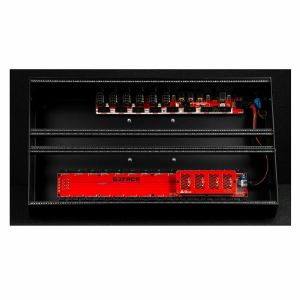
At home, stage or into the studio, the Befaco 7U Case brings your system to the next level.
Power to the people
Equipped with Befaco's latest and most sophisticated power supply (Trolley Bus), the Befaco 7U Case supplies up to 5000mA of power. Ready to feed the most modern and power-hungry modules.
Connected to the world
The Befaco 7U Case rear panel count with a vast array of connections to pair your system with external devices. Each connector follows the Intellijel format, making them fully compatible with Intellijel's 1U modules.
Build to last
Designed with a high-quality Unibody Black Anodised Aluminum frame, the Befaco 7U Case is a slim and sturdy solution to travel with. The included PET-G clear cover keeps your modules safe even patched.
Designed to fit any situation, the Befaco 7U Case metal frame is a lightweight and strong device by itself. With a maximum depth of 53mm (power supply side) and 70mm (rest of the case), it can house the vast majority of modules out there. Equipped with a high-quality anti-vandalic power button and a Kensington lock connector, the Befaco 7U Case is also a safe device to travel with.
Because power is important for us, this new Trolley Bus systems drop up to 5000mA on the +12V rail, 2500mA on -12V, and 4000mA on +5V with high voltage stability under load and low noise. The case drives up to 36 modules over its 208HP (3U) and 104HP (1U) rows (Intellijel format).
6x 6,3" Jacks I/Os with Balanced and Unbalanced configuration, MIDI In/Out/Thru ports, USB Device Type B, and Apple compatible USB-A charging ports. The Befaco 7U Case offers a huge amount of connections fully accessible from its internal I/O Board.
Created with compatibility in mind, the rear panel ports are fully compatible with Intellijel 1U modules. The 1U row can be easily customized to be at the center of the case with just two screws.
To keep your modules safe and dust free, a custom PET-G clear cover is included with the case. The cover has been designed to close patched, and a custom velcro belt is included to keep it safely closed.
To save space in your studio desk, the Befaco 7U Case is also Vesa mount fully compatible. It counts with Vesa threads at the bottom to easily attach it to desktop or wall Vesa stands.
Technical Specifications
External Dimensions (without cover): 53.5cms x 31cms x 8cms
External Dimensions (with cover): 53.5cms x 31cms x 14cms
Internal Row Dimensions: 2x 3U 104HP and 1x 1U 104HP (Intellijel format)
Power supply Specifications: +12V: 5000mA, -12V: 2500mA, 5V: 4000mA
Module Depth: 53mm (power supply side), 70mm (rest of the case)
Module Slots: 36
Weight (without cover): 2.6kg
Weight (with cover): 3.4kg
Rear connectors: 6x 6'3" Jack I/O (Balanced or Unbalanced), MIDI DIN In/Out/Thru, USB Device Type B, Apple compatible USB-A charging ports.
Power brick: 120W 2.5mm Barrel connector center positive (included)
Cover: PET-G Clear cover (included)
Finish: Black Anodised Aluminum
Vesa 100 format threads. Recommended Vesa stand: >12kg
Kensington Lock
This product is available for pre-order at Juno, for shipping on the release date. You won’t be charged until the order is despatched.
We'll keep you informed of your order at every stage, and let you know if the release date changes.
If the price of the item drops before it's released, you will pay the lower price, but if it increases, you'll only pay the price you see today.
If you also include in-stock items on your order, they’ll be charged and shipped within 24 hours as usual.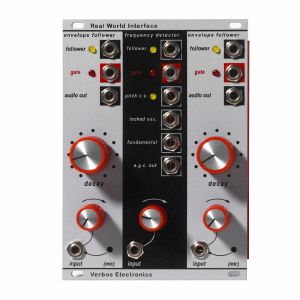
Size: 18HP
This product is available for pre-order at Juno, for shipping on the release date. You won’t be charged until the order is despatched.
We'll keep you informed of your order at every stage, and let you know if the release date changes.
If the price of the item drops before it's released, you will pay the lower price, but if it increases, you'll only pay the price you see today.
If you also include in-stock items on your order, they’ll be charged and shipped within 24 hours as usual.
Record, play and loop stereo .wav files with an SD Card. Includes the same 2022 Sampler Pack from the Stereo Triggered Sampler.
Features:
The Sampler plays stereo or mono .wav files from an SD Card. Samples are arranged into banks by placing .wav files into folders (each folder is a bank). A maximum of 10 samples can be loaded in a bank. There is a maximum of 60 banks (600 samples maximum total).
Sample files are limited to 4GB each, which is over 6 hours at 44k/16b/stereo.
Hundreds of samples included on microSD card
Extremely quiet, low noise and low jitter design
Stereo or Mono output
A knob and CV jack selects the Sample to play, and the Start Position knob and CV jack control where in the sample playback will begin. The Length knob and CV jack determine how much of the sample is played back: from tiny grains, to percussive hits, to longer loops... or just the entire file.
Pressing Play or firing a trigger into the Play Trig jack will play the sample. Holding the Play button down for a second will toggle looping.
There's also a Reverse button and jack for backwards playback, and an End Out jack for synchronizing loops, or cascading sample playback with other events.
To record samples, hold Play and Reverse for two seconds. Press Play again or fire a trigger into the Play/Rec Trig jack to start and stop recording. Each recording will create a new stereo 48kHz 24bit .wav file in the current bank's folder. Recordings can be as long as your card has the capacity for: a 256GB card is 18 days of continuous recording (432.9 hours). Audio data is split into maximum 4GB wav files on the microSD card.
Play button/trigger jack: Tapping the button or receiving a trigger starts/re-starts the sample
Sample CV/knob: select which sample within the channel's bank
Pitch CV and Pitch knob: playback pitch (-10 to +4 octave range)
Start Pos CV/knob: position in the sample to begin playback (loop start point)
Length CV/knob: playback time (loop end point)
Length knob at max: entire file is played
Length knob 50%-99%: 200ms - 5s of the sample is played (beginning at the Start Position)
Length knob <50%: Percussive decay envelope is applied to the playback (attack-only envelope if playing Reverse)
Length <1%: Tiny grains are played (can be used to sweep through sample file data manually)
Reverse button/jack: toggles forward/backwards
Bank button: selects channel's bank
Reverse + Start Pos button/knob combo allows for setting volume of playback
Maximum file size for playback: 4GB per file (6.7 hours per file at 44.1kHz/16b/stereo)
microSD Card is hot-swappable when Busy light is off: no power-down required to change cards.
Samples that are pre-loaded into memory can continue playing while card is swapped.
File Organization:
Using a computer, the intuitive automatic bank loading features make dragging and dropping your entire sample library a snap. No files need to be renamed. Just create folders and put up to 10 samples in each. If you want a folder to be associated with a particular colour of the Bank button, name the folder a colour name (such as "Blue - Loops").
Ships with a high-speed 16GB microSD card, loaded with hundreds of samples created for 4ms, from musicians such as Richard Devine, Wobbly, Moor Mother, Robert Aiki Aubrey Lowe, Joseph Pailo, Russell E.L. Butler, Hugo Paris & Marc Kate, Paul Barker, Baseck, Animal Collective, Cristian Vogel, Jay E, Marcus Fischer, Chris Carter, Daedelus, Nero Bellum, Anna Sitko, Thomas Fang, Bogdan Raczynski, and more (Sample List)
Intuitive bank/colour organization system; no need to rename your wav files
Record new samples directly to a bank with the Record Input jacks...
... or drag your folders of sound files onto the microSD card, and each folder will become a bank.
Folders starting with a colour name will be loaded into that colour bank
Example "Blue - Frooty Loops" will load into the Blue bank
Sub-folders are ignored, only folders in the root directory are scanned for wav files
Works best with UHS Speed Class 3 cards with |3| symbol printed on the card
Specs:
Electrical and Mechanical Specifications:
Module Size:
16 HP Eurorack format module
10-pin Eurorack power header
1.3" (33mm) maximum depth with power cable
Power consumption:
+12V: 135mA
-12V: 41mA
+5V rail: not used
Connect red stripe of power cable towards the bottom of the module, which is marked with a white stripe and the words -12V and POWER
Audio Inputs:
20Hz to 10kHz (+/-0.1dB); -6dB rolloff @ 20kHz
21V peak-to-peak maximum before clipping
Audio Outputs:
0Hz (DC) to 22kHz with maximum -1.8dB difference between file data and output
+10.5V to -10.5V maximum output
Trigger inputs:
Latency: 0.7us typical
Included with the Sampler:
16GB micro SD card (class 10)
SD adaptor
10-to-16 pin power cable
M3 Knurlie screws
This product is available for pre-order at Juno, for shipping on the release date. You won’t be charged until the order is despatched.
We'll keep you informed of your order at every stage, and let you know if the release date changes.
If the price of the item drops before it's released, you will pay the lower price, but if it increases, you'll only pay the price you see today.
If you also include in-stock items on your order, they’ll be charged and shipped within 24 hours as usual.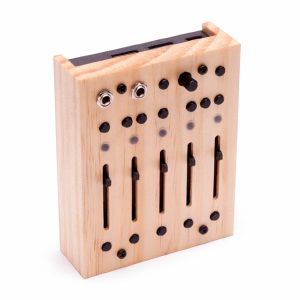
On the other hand, it helps you create new sounds! Looping and bounce down functions open up new dimensions for your sound and fun ways for your tracks to interact with each other!
The unassuming wood enclosure draws you in, but hidden inside are high fidelity electronics designed for rich recordings. Its sleek user interface offers crisp control and ample room for sonic experimentation.
Easy Interface, Rapid Results
Get straight into recording - let your creativity flow.
5 Moons' simple interface is perfect for effortlessly building up many tracks.
The immediacy of 5 Moons means you'll be quickly experimenting and exploring the new ideas flying around your studio - watch out!
One Shot or Loop?
Create evolving jazz loops and/or a 3-chord pop song.
5 Moons is happy to accommodate recording a song with a beginning and end or a looping vibe - it's all in how you decide to play back your tracks.
You'll probably do both!
Bounce with Me
Build up your song with more tracks.
At first glance, you might think 5 Moons 'only' has five tracks. But once you bounce down those five tracks to the first track of a new song, you'll have 4 more tracks to add to it!
Once those four new tracks have audio, bounce down again and you'll have another four new more tracks to play with! ...and on and on until your masterpiece is complete.
File Freedom
Disk Mode makes it easy to transfer files to your DAW.
The USB-C port is used for both power and data transfer. Connect to your computer and copy your recordings for posterity and/or additional editing.
You can also copy existing audio files onto 5 Moons. Use these files as the beginnings of new songs or use 5 Moons' interface as a way to re-envision and remix your prior tracks!
Welcoming Material
Warmth of wood invites you in.
A hunk of wood is a nice thing to look at and touch. 5 Moons' enclosure highlights a natural beauty that will inspire.
Design/Specs
Audio input/output:
1/8" Monophonic Audio Input
1/8" Monophonic Audio Output
Five Track Volume Sliders
Master Output Volume Potentiometer
Audio format:
Record Sample Rate: 48KHz
Record Bit Depth: 16-bit
Included storage:
An 8GB microSD card holds the operating system and audio storage.
There is ~7GB for available for audio storage.
This is about 20 hours total record time.
Physical characteristics:
Size: 4.25 x 3.375 x 1.375" / 10.8 x 8.5 x 3.6 cm. Height includes Volume potentiometer.
Weight: 5oz / 140g
Pine & PLA Enclosure
Included items:
Power Supply:
Input: 100-240VAC @ 50/60Hz.
Output: 5VDC
USB-A port
North American Plug
Power / Data Cable
USB-A to USB-C
Length: 40 inches / 101.6 cm
This product is available for pre-order at Juno, for shipping on the release date. You won’t be charged until the order is despatched.
We'll keep you informed of your order at every stage, and let you know if the release date changes.
If the price of the item drops before it's released, you will pay the lower price, but if it increases, you'll only pay the price you see today.
If you also include in-stock items on your order, they’ll be charged and shipped within 24 hours as usual.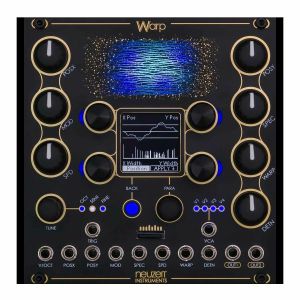
In the center of Warp's control panel is a colorful XY LED matrix that represents the sound space from which Warp draws its sounds. This XY sound space consists of 32x16 frequency spectra. Each of Warp's four voices can move freely and independently across the XY space. It always uses the surrounding frequency spectra to calculate a wavetable based on 512 sine waves in real time using additive synthesis. By changing the position, wicked wavetable sounds are possible, playable with four voices and eight oscillators and navigable in two directions. An intuitive integrated editor allows playful modeling of your own frequency spectra.
With Warp's SPEC effects the frequency spectrum can be filtered and deformed in realtime before a wavetable is calculated. The wavetable can then be modified with WARP effects like wavefolder, PWM bend, overdrive and redux. The resulting wavetable serves as source for two oscillators per voice, which can be detuned and also synchronized to each other. Each voice is followed by a 12/24dB/octave high pass and low pass filter.
Warp offers an integrated editor, with which you can playfully draw and modify your own frequency spectra. The XY-Sound Space is seen as a canvas on which you can draw your own frequency peaks. Several drawing algorithms are available as tools to edit single or a group of harmonics in a musically meaningful way. There is also the possibility to derive frequency spectra from audio samples from the SD card or to put whole wavetable audio files into the XY sound space. Likewise, the XY sound space can be exported to the SD card as a wavetable audio file of any length and bit depth, so Warp can also be used as an intuitive wavetable generator for other synthesizers.
Also on board are two internal ADSR envelopes and two LFOs, which can be routed to a variety of internal destinations using a modulation matrix. To keep the overview, all modulations are color-coded and are additionally visualized by pulsating LEDs in the modulation matrix view.
Navigation through the menu is as intuitive as with our QUASAR module and is simply done via a push-encoder and a back button. The display always shows which function the four surrounding aluminum encoders currently have, and colored LEDs next to the encoders provide visual assistance. Likewise, the tuning of the module is done via a detented encoder, which adjusts the pitch either in fine steps, in semitones or in octaves. An octave switch is thus already integrated.
For all its feature-richness, Warp still remains a playable and performance-oriented instrument. The large potentiometers serve as macro controls to control several parameters under the hood at once. This keeps the instrument straight forward with a manageable number of controls, but they are all very expressive.
Likewise, the module offers the ability to save and load presets and also comes with audio files and presets on board. Thus, Warp is ideally suited for both detail-oriented sound design and hands-on performance.
In the standalone version, Warp is a monophonic four-voice synth voice that can also be used as an oscillator. With an expander module, it will also be possible to play Warp four-voice polyphonic via MIDI and CV/Gate in the future.
Warp uses a novel hybrid engine that combines the best of additive and wavetable synthesis. With the integrated editor you can playfully draw your own frequency spectra like on a canvas into the colorful XY sound palette. Warp is a feature-rich powerhouse that lets you create all kinds of sounds, from glassy clean to crunchy crunch. Thanks to expressive macro tone controls, extreme morphs are possible in a single pot turn.
Main functions
4 Voices & 2 oscillators using a hybrid additive-wavetable synth engine
Big knobs act as macro controls for underlying parameters and enable expressive Hands-On playability
Polyphonic with expander, monophonic as standalone unit
Usable as a full synth voice or as an oscillator module
Additive synthesis with 512 sine waves per oscillator = 4096 sine waves in total
XY sound space as a collection of 32x16 frequency spectra
Each voice travels independently across the XY space and uses the underlying spectra to synthesize a wavetable in real-time
Spectral FX are applied on the spectrum before a wavetable is generated
Wavetable FX are applied once the wavetable is generated, e.g. Wavefolder, PWM-Bend, Redux, Overdrive
Two Post-Filters per voice: 12/24dB Lowpass and Highpass with resonance control
Independent oscillator settings per voice, e.g. volume, pitch, stereo pan, detune, sync, X/Y position
Integrated modulation by 2x ADSR, 2x LFO with many waveforms
Modulation matrix view to see everything that is going on at once
Integrated editor for playful drawing of own frequency spectra
Algorithms for musically meaningful drawing of harmonics
Width: 24 HP
Depth: 30 mm
Current draw +12V: 205mA
Current draw -12V: 20 mA
Current draw +5V: 0 mA
** Includes 3mm screws, 16-Pin to 10-Pin eurorack power cable, USB cable for firmware updates **
Warp uses a novel hybrid engine that combines the best of additive and wavetable synthesis. With the integrated editor you can playfully draw your own frequency spectra like on a canvas into the colorful XY sound palette. Warp is a feature-rich powerhouse that lets you create all kinds of sounds, from glassy clean to crunchy crunch. Thanks to expressive macro tone controls, extreme morphs are possible in a single pot turn.
This product is available for pre-order at Juno, for shipping on the release date. You won’t be charged until the order is despatched.
We'll keep you informed of your order at every stage, and let you know if the release date changes.
If the price of the item drops before it's released, you will pay the lower price, but if it increases, you'll only pay the price you see today.
If you also include in-stock items on your order, they’ll be charged and shipped within 24 hours as usual.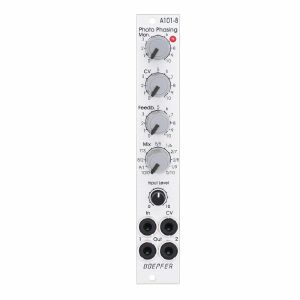
The module has these controls and in/outputs available:
Control Man. : manual control of the phase shift offset (base value)
Control CV: attenuator for the signal applied to the CV socket
Control Feedb.: Feedback or Resonance (similar function as filter resonance/feedback/emphasis)
Control Mix: sets the mixing ratio between original and phase shift signal appearing at output 1
fully CCW: only the modified input signal appears at output 1 (see note below *)
center: a mixture between the modified input signal and the phase shift signal appears at output 1, that's the standard position for the classical phasing effect
fully CW: the pure phase shifted signal appears at output 1 (e.g. for vibrato effects)
Control Input Level: attenuator for signal applied to the In socket
Socket In: audio input
Socket CV: control voltage input
Socket Out 1: audio output 1 (mix signal)
Socket Out 2: audio output 2 (modified input signal)
LED: visual control of the phase shift
The module has some peculiarities (same as the historic model):
The input signal is processed at first by a pre-stage which outputs a "modified" input signal (*). This signal is not processed by the phase shift stages but is affected by the feedback setting. Only when feedback is set to zero this signal is identical to the input signal. Otherwise it contains feedback components.
This signal is output on socket Out 2.
When both output sockets Out 1 and Out 2 are used as stereo channels one obtains a spatial stereo sound effect.
The same signals is also used for the CCW position of the mix control. With mix control fully CCW the unmodified signal appears only if the feedback control is set to zero. Otherwise it contains feedback components.
The historic model had two audio inputs: one 5-pin DIN socket and a 1/4" jack socket. The DIN socket was intended for high-level line signals. When the 1/4" jack socket was used the amplification of the pre-stage increased by about 100. The 1/4" jack socket was intended for low level signals (e.g. electric guitars or microphones). For this feature the A-101-8 has an internal jumper that can be used to increase the amplification. As long as the module is used within the A-100 system usually the lower amplification is used to avoid distortion.
The 8 photo resistors and LEDs are assembled within an small lighproof box. In addition the pc boards are made of lighproof black material to avoid interfering light from other modules or the bus board.
Dimensions
4 HP
45 mm deep
Current Draw
30 mA +12V
30 mA -12V
This product is available for pre-order at Juno, for shipping on the release date. You won’t be charged until the order is despatched.
We'll keep you informed of your order at every stage, and let you know if the release date changes.
If the price of the item drops before it's released, you will pay the lower price, but if it increases, you'll only pay the price you see today.
If you also include in-stock items on your order, they’ll be charged and shipped within 24 hours as usual.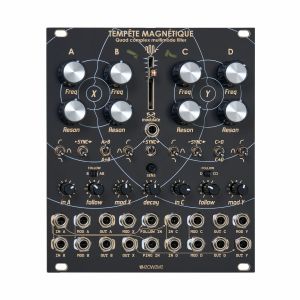
It was that was created as an evolution of the "Fluctuations magnetiques".
More than a mk2, Eowave designed it to push you to play with one of the most interesting things in modular synthesis: to divert the primary usage of a module to create unexpected and new sounds (aka this is not only 4 filters)
Tempete Magnetique is deeply inspired by the classical filters design as well as West Coast synthesis complex oscillators.
At it's core, has 4 multi-mode 12db filters that can be chosen to be routed in series or parallel, which can be used independently or combined and even cross-modulated, controlled by CV or with an integrated envelope follower (which can be used as a dynamic responsive envelope) and even pinged.
The Tempete Magnetique was designed to have several levels of use. The individual level with the use of separate filters, perfect for quadraphonic processing of different sources (A B C D).
The pair sections which allows for more complex stereo effects or to generate synthesis voices (X, Y) and finally, the global level with a cross-modulation of filters.
The independent outputs have been designed to be fed back into their input, turning them into oscillators (not really precise one, but you can make synth voice kind of V/Oct tuned with their very own sound, due to the fully analogical design, these oscillators may have strange behaviours sometimes, but this instability will bring you the warmth of analogue gears).
The pairs sections, of course, can filter an incoming signal, but can be transformed to full synthesis voice, percussion engine (exited by the ping input and modulated with the envelope follower) and way more.
This filter allows for anything from gentle, subtle filtering to a storm where the undulations of your sound and their intensity create new types of textures.
Main features:
Four independents or linkable multi-modes 12 db filter
Envelope follower who can act as end decay envelope sensible to the velocity
Cross modulation engine who modulate both pair of filters
Ping input
Outputs with phase correction to be fed to inputs
Some applications:
Filtering (obviously), can be used for quadraphonic or stereo filtering
Weird synth voice
Waveshaper
LFOs/oscillators generator
Crossover
External rhythm following - auto filtering
Drum generator
Technical details
22hp
Skiff friendly
Reverse power protection
This product is available for pre-order at Juno, for shipping on the release date. You won’t be charged until the order is despatched.
We'll keep you informed of your order at every stage, and let you know if the release date changes.
If the price of the item drops before it's released, you will pay the lower price, but if it increases, you'll only pay the price you see today.
If you also include in-stock items on your order, they’ll be charged and shipped within 24 hours as usual.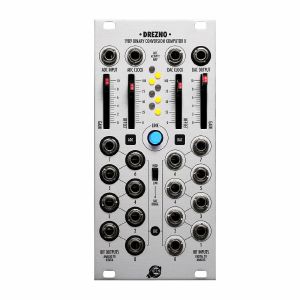
Drezno features an ADC (analogue-to-digital-converter) and DAC (digital-to-analog-converter), allowing it to act as an analog front-end of the system. In other words, Drezno allows one to convert analog signals and CVs into digital numbers, as well as to obtain analog signals back from some other digital numbers (or 8 binary signals). Between these two conversions there is a whole universe of digital shenanigans waiting to happen resulting in all kinds of signal transformations and modulations.
Both (ADC and DAC) sections of Drezno can work independently, or they can be linked. Input and output range of analog signals may be adjusted using Gain and Offset sliders. Individual bit outputs (for the ADC) and inputs (DAC) allow for extensive cross-patching and the creation of complex waveforms and rhythms. A very fast clock (up to 2MHz) at which the conversions are performed may be replaced with any external clock (for each section separately).
Compared to its predecessor, Drezno II uses new converters of much higher resolution which results in much lower noise floor and higher accuracy. The lower bits are much more stable than before. It is easy now to use Drezno for quantizing pitch voltages with accurate results with 128 or 256 semitone steps. Potentiometer ranges are factory calibrated for precise chromatic scale. A new switch on the front panel allows the user to select the calibrated range of 10Vpp or 20Vpp, so that the lowest bit or the second bit correspond to 1 semitone.
Technical details
Eurorack synth compatible
12hp, skiff friendly
Current draw: +80mA/-50mA
Reverse power protection
This product is available for pre-order at Juno, for shipping on the release date. You won’t be charged until the order is despatched.
We'll keep you informed of your order at every stage, and let you know if the release date changes.
If the price of the item drops before it's released, you will pay the lower price, but if it increases, you'll only pay the price you see today.
If you also include in-stock items on your order, they’ll be charged and shipped within 24 hours as usual.
Some tech-talk:
A chorus effect is created by mixing a dry signal with a delayed signal. The delay time is modulated by an LFO to create more movement. To create some stereo width, the left and right modulation are 180 degrees out of phase. Exactly like the chorus in the Juno 6/60/106, the delay is made with MN3009 BBD chips. Also as in the original design, filters are added both before and after the BBD chips in an attempt to hide some of the artefacts of this very crude IC.
To get the audio "moving" through the chain of MOSFETs in the BBDs, driver signals are needed. This used to be done with the MN3101 BBD driver chip. Unlike the MN3009, there is no clone available of this ancient IC and this was a chance to add some modernity to the design. The drivers were replaced by a modern STM32 micro-controller along some extra ICs to convert the 3.3V logic to the negative voltage needed by the MN3009.
In order to recreate a genuine Juno-type modulation, the BBD driver signals of my Juno-106 were sampled over a few periods. Using the timer peripherals of the STM32, a replica of the BBD driver signals can be sent out to the MN3009's. Although the driver signals only follow a very basic triangle LFO shape and could have been generated using direct synthesis in the firmware, this method gives an exact copy of the original driver signals including all the potential imperfections.
Implementing a digital programmable chip also allows a digital-style interface with tactile switches and LEDs as in the original Juno interface. The last used mode is saved and loaded when the module powers on. The CV inputs (with the exception of the MIX CV) are acquired by the STM32 ADC and can modulate the BBD driver signals based on parameters in the firmware.
Features:
The SoundForce Chorus 6 has 4 main modes: I, II, I+II, MAN for manual and EXT for external. I and II are the classic Juno modes available in the Juno 6/60/106. Press both I and II to enter the I+II mode. While holding down I and II, press the OFF button to cycle through the 4 I+II options:
- Juno 60 mono - 1hz - 8% depth
- Juno 60 stereo - 1hz - 8% depth
- Juno 6 mono - 8hz - 25% depth
- Juno 6 stereo - 8hz - 25% depth
In I, II and I+II, only the mix controls can influence the sound, all the other parameters are fixed and CV inputs are not active.
Mix control:
Using the slide pot (fader) or the CV input, the mix between the dry input signal and the BBD delays output can be set. The orignal Juno balance is reached when the slide pot is in the middle (without CV connected). The mix control is a VCA-based crossfader and is 100% analog which means it can withstand really high audio rate frequency modulation.
MAN mode:
The manual mode gives you the opportunity to control every parameter of the chorus and gives you acces to the LFO that modulates the BBD delay times. Here is what you can tweak:
- time slide pot: sets the start delay time
- rate slide pot and CV input : sets the frequency of the delay time modulation
- depth slide pot and CV input: sets the depth of modulation around the start time
- mix slide pot and CV input: see above
- LFO wave: selection of different waveforms to modulate the delay time
- range: selection of 3 different frequency ranges for the LFO (S: 30Hz to 500Hz | M: 1Hz to 100Hz | L: 0.016Hz/1min to 10Hz)
In manual mode, the EXT IN CV input can be used to change the LFO wave, range or add additional modulation of the delay start time.
EXT mode:
In external mode, the BBD delay times can be modulated using an external signal through the EXT IN cv input. Plug in a CV source from your eurorack case into the EXT IN, set manually the starting delay time using the time slider and use the EXT ATT slide pot to attenuated the incoming CV signal (equivalent to setting the depth). In external mode, the depth/rate sliders and CV inputs are not active.
Stereo inputs:
The Chorus 6 can be used with either mono or stereo input signals. When the right channel is unconnected, the left channel is sent to the right jack so it can be used with mono signals. When using both inputs, each input signal is going through its own BBD delay line.
BBD delay time range:
The Chorus 6 gives you in the MAN and EXT modes a delay range that it is about doubled compared to the I/II modes. The original Juno chorus was using only a very limited range of the BBD chip and really stayed in the sweet spot. Extending to the full spectrum of the MN3009 yields pretty horrible high pitch noise at audio rate modulation, so the range has been limited to a usable section. When you apply high frequency modulation with great amount of depth, the delay time will be pushed in the extremities of its time range and quite nasty artifacts will appear in the form of squeaks and whines. Please note this is a characteristic of the BBD. If you want to reduce those artifacts, reduce the depth of modulation. On the other hand, if you are looking to add characteristic and vibe to the sound, audio rate modulation and plenty of depth will help you to get there.
Input levels:
Both Eurorack and Line level signals can be used as input for the Chorus. A small slide switch between the 2 PCBs can switch between Euro and Line. In Euro levels, the input signal is attenuated to an healthy level that is well below the BBD distortion point. Some headroom is also needed as the chorus is a sum of the input signal and the modulated delayed signals. For that reason, when the chorus is turned off the output attenuation is about 50% of the input level. When the chorus is on, the resulting output amplitude is similar to the input level. Line levels are also accepted by the module when the switch is on Line. Please note that Line levels input will be amplified to the Eurorack levels range at the output of the module. So the output levels are Eurorack in both Euro or Line input ranges.
Specifications:
16HP
Depth: 38mm (including power connector)
Power: +12V 76mA, -12V 35mA
This product is available for pre-order at Juno, for shipping on the release date. You won’t be charged until the order is despatched.
We'll keep you informed of your order at every stage, and let you know if the release date changes.
If the price of the item drops before it's released, you will pay the lower price, but if it increases, you'll only pay the price you see today.
If you also include in-stock items on your order, they’ll be charged and shipped within 24 hours as usual.
An indispensable utility module, Bias 2 provides a compact yet precise solution to quickly interface signals between modules within a Eurorack modular system, without interrupting your creativity.
Comprising of two independent sections, each with dual inputs and dual outputs, its carefully selected combination of normalised reference voltages and amplification/attenuation factors makes it a breeze to convert between the most common signal ranges: -5 to +5 V, 0 to +5 V and 0 to +10 V.
Precision comes standard on Bias 2, with meticulously engineered analogue signal paths providing absolutely transparent performance for any Eurorack signal: CV, audio or gates/triggers.
Beyond the voltage conversion application, Bias 2 is a true all-rounder, capable of functioning as a pair of dual input unity gain mixers, -6 and +6 dB audio gain stages or a multi-output fixed voltage source.
2 HP | +12: 20 mA, -12: 20 mA
This product is available for pre-order at Juno, for shipping on the release date. You won’t be charged until the order is despatched.
We'll keep you informed of your order at every stage, and let you know if the release date changes.
If the price of the item drops before it's released, you will pay the lower price, but if it increases, you'll only pay the price you see today.
If you also include in-stock items on your order, they’ll be charged and shipped within 24 hours as usual.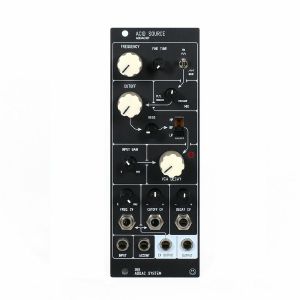
It features a VCO with a [FREQUENCY] and [FINE TUNE] knob plus a dedicated CV Input and Attenuator knob (tunable over 4 octaves).
The VCO waveform output is achieved by selecting either a Triangle or Saw through a switch. the selected waveform can then be mixed/balanced against the square wave. The resulting mix is then sent to the Filter.
The Filter features a [CUTOFF] and [RESO] resonance knob plus a Cutoff CV Input and Attenuverter knob.
A 3 position switch is used to select the filter type: Highpass, Bandpass or Lowpass.
The resulting output is then sent to the VCA.
The VCA features an Input with [INPUT GAIN] knob which at maximum can amplify the incoming signal by a factor of 2.
This is a very important control, it accepts any signal Trigger, Gate or CV. Whatever input is plugged in the signal is then fed through an AD with a very short attack and controllable decay through the [VCA DECAY] knob plus the CV Input and Attenuverter knob. The resulting slewed signal is then used to control the VCA gain.
This signal is also sent to the CV OUTPUT as well as the LED monitor.
The Accent input adds to the Input signal creating a different amplitude output.
The CV OUTPUT is normalled to the Frequency and Cutoff inputs.
Tech Specs:
9HP
4cm deep
80mA +12V
80mA -12V
The [INPUT GAIN] knob
Usually Attack/Decay envelopes have a maximum voltage of +5v, no matter if the input gate is +5v or above the AD will clip at +5v. In this case, this clipping method was not used, and instead ADDAC allowed the incoming voltage to determine the maximum AD voltage, meaning that if a +5v gate is present then the AD maximum voltage will be +5v but if a gate of +10v is sent then the AD maximum voltage will be +10v.
This also means that with higher input voltages the decay, although falling at the same speed, will be longer than with lower voltages as it has a longer range to go back to 0v.
As previously mentioned, The [INPUT GAIN] knob can amplify the incoming input by a factor of 2, allowing to use a standard +5v gate or envelope and being able to make the resultant AD go up to +10v.
The AD signal is responsible for opening the VCA. Up to +5v the VCA will open to unity gain above this value the VCA will start to amplify and eventually saturate and distort. This saturation will add harmonics to the signal which will change its gentle timbrical nature to a more unique and peculiar timbre that will make the module shine in Acid contexts.
Adding high levels of Resonance or even filter self oscillation in combination with high VCA saturation will create even more harmonics that ADDAC highly encourage the user to explore.
This product is available for pre-order at Juno, for shipping on the release date. You won’t be charged until the order is despatched.
We'll keep you informed of your order at every stage, and let you know if the release date changes.
If the price of the item drops before it's released, you will pay the lower price, but if it increases, you'll only pay the price you see today.
If you also include in-stock items on your order, they’ll be charged and shipped within 24 hours as usual.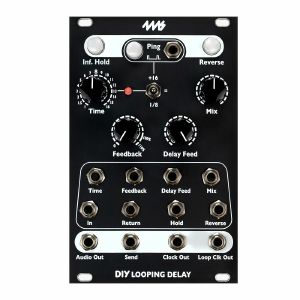
Features:
Loop or echo time is synchronized to a clock
87 seconds of delay/loop time maximum
48kHz/24-bit sampling rate, loop recorded at 16-bit (24-bit optional)
Extremely quiet, low noise and low jitter design
Tap tempo button and clock Ping input set the basis for one "beat"
Delay/loop time set as a number of musical beats (or fractions of beats) using the Time knob, switch, and CV jack
Sample-accurate clock output for perfect synchronization
Loop clock outputs for each channel
Time switches change range of Time knob from 1/8th notes up to 32 bars
Digital feedback, up to 110%
Delay Feed control, independent of dry/wet signal mix
Infinite Hold mode disables recording input and fixes regeneration at exactly 100%
Reverse mode plays memory contents backwards
With an infinite loop locked, knobs or CV can "window" around memory, by shifting the loop
Trigger inputs for toggling Infinite Hold and Reverse
Send and Return for applying effects to feedback with external modules
CV jacks to control Time, Level, Feedback and Dry/Wet Mix
16HP Eurorack module
Specs:
48kHz, 24-bit low-noise hi-fidelity
Up to 90 seconds of loop time
16HP
+12V: 110mA
-12V: 45mA
Included with the Looping Delay:
16-to-16 pin power cable
4 x M3 Knurlie screws
This product is available for pre-order at Juno, for shipping on the release date. You won’t be charged until the order is despatched.
We'll keep you informed of your order at every stage, and let you know if the release date changes.
If the price of the item drops before it's released, you will pay the lower price, but if it increases, you'll only pay the price you see today.
If you also include in-stock items on your order, they’ll be charged and shipped within 24 hours as usual.
Features:
Rackable (38HP eurorack) modular desktop unit.
8 CV inputs with led level indicators.
6 main functions: Prefilter / Digital / Analog / Mixer / Envelope Follower / Feedback
Prefilter: High Pass and Low Pass filters to shape the sound before being processed. Both controllable via fader + CV input.
Digital: 12 bit Bit Crusher / Bit mute, Biswap and Bit inversion + Sample Rate reducer. Both controllable via potentiometer and CV inputs. It also offer an analogue input control with led clip indicator and a low pass filter to smooth the output signal. All the code will be Open Source
Analog: 7 analogue distortion circuits selectable with a rotary encoder + a sweet resonant state variable filter. Drive and Cutoff parameters are controllable via potentiometer and CV inputs. 2 of the circuits use the new Korg NU-TUBE.
Mixer: Dry and Wet controls to mixed the processed signal with the clean one of the input. Both controllable via fader + CV input.
Envelope Follower: A dedicated envelope follower with gain control and normal and inverted outputs to convert an incoming signal to an envelope. With its output you can control any of the CV parameters and shape the processed sound in many creative ways.
Feedback: a triple feedback section that sends the Wet input to the Prefilter, Digital and Analog sections. It's capable from a subtle resonance to a collapsed hardcore self generating tone.
Semi-modular architecture with pre-patched sections that can be restructured using patch cables. Each section (minus the feedback) can be used as an independent function from the rest.
This product is available for pre-order at Juno, for shipping on the release date. You won’t be charged until the order is despatched.
We'll keep you informed of your order at every stage, and let you know if the release date changes.
If the price of the item drops before it's released, you will pay the lower price, but if it increases, you'll only pay the price you see today.
If you also include in-stock items on your order, they’ll be charged and shipped within 24 hours as usual.
CM-1; the latest addition to Teenage Engineering's field system.
A versatile studio quality, ultra-portable microphone that comes with a built-in professional SUB-C audio interface with built-in preamp. Add a 3.5 mm jack and a 48v phantom powered mini XLR, and you have a truly one-of-a-kind battery-powered studio microphone.
A rarity in the field.
Large-diaphragm capsules are preferred for professional recording, but are rare within the world of portable equipment. CM-15 features an ESS sabre analogue-to-digital converter, preserving high-fidelity sound and capturing exceptional detail in any recording situation.
Clean, mean and lean mic-machine.
Clean, rich, transparent and natural sound. Period.
Use the gain switch on the back for padding those mean drums, or the other way around. Battery-powered with an integrated audio interface and preamp, cm-15 is always ready to use wherever you like to record. In other words: 'lean operation'.
CM-15 includes a standard 1/4" and 3/8" adapter, making it universally compatible with standard mic stands and tripods.
The included adapter allows for a 90- to 110- tilt, so you can mount the mic onto a boom arm or to better record overheads. Use tripod mini for portable setups (available separately).
Dynamic sound for any occasion.
Teenage Engineering's first microphone also means a unique sound quality to discover.
Rich, transparent and natural, cm-15 captures clear and clean sound for professional audio productions, always ready to set up wherever you like to record.
Pure craftsmanship.
CM-15 is an incredibly versatile microphone, both inside and outside the studio. The large-diaphragm condenser capsule essentially means you get a better signal, so there is less noise and better depth of sound.
Vocal recording
As a directional mic, CM-15 is perfect for the vocal booth, focused on picking up sounds in front of it.
Instrument recording
With the flattest frequency response at a 50 cm distance, CM-15 is perfect for capturing a variety of instruments, including your drum kit.
Interview/podcast
CM-15 is great for podcasts and interviews, where high audio quality and portability is necessary.
Field production
With a compact form factor and 10 hour rechargeable battery, it's a great tool for every 'trip'.
Camera mic
When filming with a video camera, connect CM-15 through the line out to record synced audio directly.
Multi-use connectivity.
CM-15 has multiple outputs that can be used simultaneously:
mini XLR, 3.5 mm jack and USB-C. It can also be powered three ways, through phantom power, battery or USB-C, instantly detecting the right power source for your connected device.
On the bottom side of CM-15, you will find three audio outputs: mini XLR, 3.5 mm jack and USB-C. The built in table stand can be used to rest and angle the microphone on a surface.
CM-15 includes a mini XLR to XLR cable for connecting to your recording console. The 3.5 mm jack can be used with headphones, while USB-C is used for digital audio interface connection, firmware updates and charging.
Technical specifications
CM-15 highlights
1-inch large-diaphragm capsule
10 hour rechargeable battery
48 V phantom power compatible pseudo-balanced mini xlr output
dual mono 3.5 mm jack line output
USB-C class compliant device with high performance
ESS sabre ES9822Q PRO analogue to digital converter
Dimensions and weight
90 mm x 65.5 mm x 19 mm
132 g / 54.6 oz
Audio characteristics
Self noise: 14 dBA
Max SPL for 0.5% THD: 138 dB
USB SNR dBA FS: 120 dB
Polar pattern: supercardioid
Polarity: positive
The field system.
CM-15 is part of Teenage Engineering's ultra-portable sound recording and performance system. All battery-powered, rechargeable via USB-C and with full interconnectivity (MIDI and high resolution audio). Compatible with iOS, macOS, and windows it's the most powerful, highest quality, portable system in the world 'as we know it'.
This product is available for pre-order at Juno, for shipping on the release date. You won’t be charged until the order is despatched.
We'll keep you informed of your order at every stage, and let you know if the release date changes.
If the price of the item drops before it's released, you will pay the lower price, but if it increases, you'll only pay the price you see today.
If you also include in-stock items on your order, they’ll be charged and shipped within 24 hours as usual.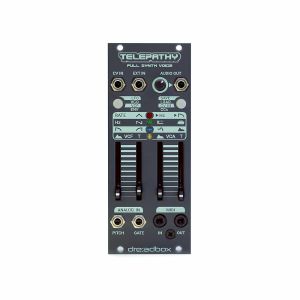
With lots of useful and musical features integrated into a compact size (10hp), and its skiff friendly design, Telepathy is a great addition to small or large Eurorack systems.
Features:
1x Analogue Oscillator with saw, square, -1 oct square sub and noise, plus PW control for square, level for noise and waveshape
Automatic tuning for the oscillator and fine tune
Analogue 24db Resonant Low pass filter with Oscillator FM and Noise FM and 6db High pass filter
Analogue VCA
1x LFO with Free/Key/Track/BPM/BPM Key modes, Fade in, Triangle/Saw/Ramp/Square/Random waveforms, that is mapped to various parameters
2x Envelopes, one dedicated to the VCA with Velocity control and one loopable for Low pass Filter, Pitch and PW
CV in patch that can be mapped to all the basic parameters in parallel with dedicated amount for each parameter
MIDI in/out+through
CC in/out, Program Change in/out
Multitimbral Chaining functionality via MIDI up to 8 modules 16 presets
10HP
This product is available for pre-order at Juno, for shipping on the release date. You won’t be charged until the order is despatched.
We'll keep you informed of your order at every stage, and let you know if the release date changes.
If the price of the item drops before it's released, you will pay the lower price, but if it increases, you'll only pay the price you see today.
If you also include in-stock items on your order, they’ll be charged and shipped within 24 hours as usual.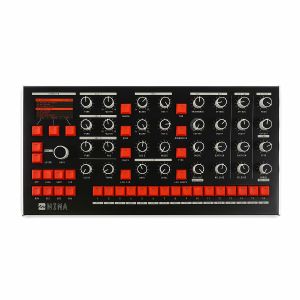
NINA: 12 Voice Analog Polysynth
4 part Multi-timbral
Motorized, recallable, automatable, assignable, and robust high resolution control panel
Unlimited & quick to edit Modulation Matrix
3 Oscillators per voice. 2 Analog VCOs, 1 Digital Wavetable.
Patch morphing
Onboard effects
NINA Specifications
Oscillators
3 Oscillators per voice. 2 Analog VCOs, 1 Digital Wavetable.
Oscillator 1 & 2 with waveforms morphable between triangle to sawtooth and PWM square-wave.
Sub octave mode for VCO 1 square wave.
Hard Sync Oscillator 2 from VCO 1.
Fine & Course tune control with up to 8 octave range.
96kHz 24bit Wavetable Oscillator Resolution.
User loadable Wavetables.
Selectable Fuzz & Noise sources - Pink, White, Oscillator 1 & 2 XOR (Fuzz).
LFO with selectable shapes, through-zero modulatable rate & level controls.
VCF
Classic 4 pole transistor ladder VCF
Modulatable resonance, available as a matrix destination.
Extremely over-drivable, or perfectly smooth low noise modes.
Dedicated control for Envelope to Cutoff modulation amount.
VCA
Traditional ADSR envelope with ultra-fast slopes possible.
Melbourne Instruments designed four-quadrant (through zero) VCA.
Stereo: 2 VCAs per voice.
Infinite panning.
Unison polyphony
Play up to 12 voices in unison or polyphonically.
Mono Triggered and Legato modes.
Selectable polyphonic panning schemes
Modulation
Extensive modulation matrix. 16 sources to 27 destinations. No bus count limitation.
Morphable modulation settings.
Quick to edit MOD mode. Select a source and dial in amounts instantly on control panel.
All MOD amounts are through zero (bipolar)
Patch morphing
Morph between patches to create new timbres.
Morph entire patch including Modulation Matrix.
ADSR envelope generators
2 x ADSR envelopes available as mod sources
Modulate Attack, Decay, Sustain, Release, and Level using velocity or any other mod source
Multi-timbral layers
Up to 4 layers for 4 Timbres controllable via MIDI channel and note ranges
User selectable number of assigned voices per layer
Optional linked note ranges across layers for quick keyboard splits & layering
Effects
Upgradable VST3 effects algorithms built on an Open Source architecture.
96kHz 24bit resolution
Parallel or Series mix modes. Parallel mode retains analogue sound.
Sequencer
Up to 16 Step Polyphonic
Adjustable note value
Hold mode
Send Sequencer to Arpeggiator
Tempo sync from external source
Computer
Hackable Open Source software built on a powerful Raspberry Pi 4 running Elk Audio OS.
Connectivity
Audio Out
4 assignable line level outputs.
Stereo main outputs with effects.
Aux outputs (3 & 4).
Headphone output.
Audio In
3 TRS Balanced Line or CV Inputs.
1 TRS/XLR Combo. Mic for line/CV input.
CV +/-10V max. Analog gain and offset trim.
Physical
Weight: 5.5kg (12.1lb)
Dimensions (length x width x depth): 446mm x 230mm x 71mm.
Solid metal construction.
19" rack mount ears available.
This product is available for pre-order at Juno, for shipping on the release date. You won’t be charged until the order is despatched.
We'll keep you informed of your order at every stage, and let you know if the release date changes.
If the price of the item drops before it's released, you will pay the lower price, but if it increases, you'll only pay the price you see today.
If you also include in-stock items on your order, they’ll be charged and shipped within 24 hours as usual.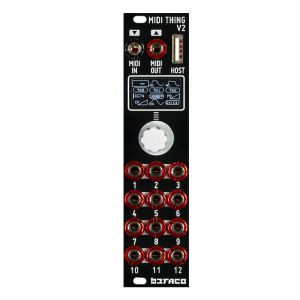
Midi Thing v2 is a flexible MIDI to CV converter. Allowing polyphonic notes handling, envelope and LFO generation as well as all available MIDI messages to be converted into CV.
This is a huge upgrade from the previous beloved MIDI Thing, which adds a screen for easy configuration,12 assignable ports, TRS, USB Host and Device, MIDI merge OUT, a web configuration tool, and a VCV rack Bridge counterpart.
This product is available for pre-order at Juno, for shipping on the release date. You won’t be charged until the order is despatched.
We'll keep you informed of your order at every stage, and let you know if the release date changes.
If the price of the item drops before it's released, you will pay the lower price, but if it increases, you'll only pay the price you see today.
If you also include in-stock items on your order, they’ll be charged and shipped within 24 hours as usual.
3DVCA is designed to be used in the following functions:
Quad monophonic crossfader
Dual stereo crossfader
Stereo balancer
Stereo VCA
Mono to stereo panner
Unity mixer with up to eight inputs
Quadraphonic panner
Each output has a dedicated SUM input which allows an external signal to be automatically mixed into the output signal. This allows 3DVCA to daisy chain both with other mixers and other 3DVCAs. For example, you can create a full mono, stereo, or quadraphonic mix by plugging the output of each 3DVCA into the sum inputs of the next 3DVCA in the chain. Using this method, a set of 3DVCAs can create a fully voltage controlled and decentralized mixer which ties together anything from a small skiff to a monster synth.
When 3DVCA works as a crossfader or panner, the X and Y parameters follow an equal-power curve that keep output signals at the same volume no matter how many inputs are mixed together. This is in contrast to the Z parameter which follows a linear curve to always behave predictably with external modulation sources. All inputs are fully DC coupled in order to work with modulation speed signals as well as static DC voltage sequences; this means that 3DVCA can handle any sort of signal that you throw at it. All op amps in the device employ rail-to-rail inputs and outputs to enable the largest headroom when mixing many different signals together.
Whether you need to maximize your mixing functionality in the smallest possible footprint or have the most control over every aspect of your system, 3DVCA provides a ton of functionality in any system. Enter a higher dimension of sound with the Mystic Circuits 3DVCA.
Dimensions
6 HP
30 mm deep
Current Draw
45 mA +12V
45 mA -12V
This product is available for pre-order at Juno, for shipping on the release date. You won’t be charged until the order is despatched.
We'll keep you informed of your order at every stage, and let you know if the release date changes.
If the price of the item drops before it's released, you will pay the lower price, but if it increases, you'll only pay the price you see today.
If you also include in-stock items on your order, they’ll be charged and shipped within 24 hours as usual.
The shift register includes eight gate outputs and three variable CV outputs derived from the state of those gates. CV 1 is determined by OO, O1, O2, and O3. While O2, O3, O4, and O5 correspond to CV 2 and O4, O5, O6, and O7 make up CV3. This grouping of stages creates three copies of the same data shifted by two clock pulses. Each CV output includes variable control over the amplitude. CV1 and CV2 include attenuverters and CV3 uses an attenuator. The eight pseudo-random gate outputs work great as both timing and modulation sources, particularly when used with percussive modules.
Data comes from the data gate input, manual seed button, and three feedback taps from the shift register itself; with each part of the data stream XOR'd with the other parts. While the module includes a voltage-controlled clock normalized into the clock input, it accepts a wide range of external clock sources, from sub-audio to audio, all the way to video rate signals. The module includes normalization from CV3 to the CV input on the clock oscillator, creating a self-influencing feedback configuration without the need for any patch cables. When using an external clock signal, the internal clock works great as a data source by patching from the clock output to the data input.
This product is available for pre-order at Juno, for shipping on the release date. You won’t be charged until the order is despatched.
We'll keep you informed of your order at every stage, and let you know if the release date changes.
If the price of the item drops before it's released, you will pay the lower price, but if it increases, you'll only pay the price you see today.
If you also include in-stock items on your order, they’ll be charged and shipped within 24 hours as usual.
· inverting and non-inverting inputs (summed).
· Exponential control input (unipolar).
· Linear control input (bipolar).
· SYMMETRY control (input offset).
· Initial gain setting.
· Dual bicolour led level indicator. Each indicates either the positive or negative going portion of the signal.
Saturation begins to occur once the output amplitude surpasses 5 volts, and increases between 5 and 6 volts. Beyond 6 volts signal amplitude, the output moves beyond saturation into full distortion.
The led scheme is as follows: green indicates a clean signal, yellow indicates saturation, and orange is distortion.
Input attenuators on the control inputs allow you to dial anything from clean to clipping.
Dimensions
12 HP
25 mm deep
Current Draw
35 mA +12V
35 mA -12V
This product is available for pre-order at Juno, for shipping on the release date. You won’t be charged until the order is despatched.
We'll keep you informed of your order at every stage, and let you know if the release date changes.
If the price of the item drops before it's released, you will pay the lower price, but if it increases, you'll only pay the price you see today.
If you also include in-stock items on your order, they’ll be charged and shipped within 24 hours as usual.
Built-in touch contact and 1/8" TRS jack sensor interface. Other sensors and devices like expression pedals can be easily added. DIY info coming soon.
Calibration mode. Sensors produce different readings in different environments, the Sensory Coupler calibrates them to utilize the entire 0-10V CV output range.
CV output based on calibrated or raw sensor data. 0-10V.
Two gate outputs. Work based on an adjustable threshold level. When the sensor reading is above or inside the threshold, GATE will output 12V while !GATE will be 0V and vice versa.
Smoothing modes. Sensor readings can be chaotic when you might not want them to be so there are two smoothing modes. One simply averages readings to create slow rises and falls while the other acts like an envelope follower with adjustable decay.
Large LED strip display. Visualizes the sensor reading, threshold, smoothing mode and more.
USB MIDI standalone mode. The Sensory Coupler can work without modular +-12V power, getting power with the built in USB-C connector and sending and receiving MIDI notes and CC. In USB mode gate outputs work at 4V instead of 12V but CV out is disabled.
Includes:
Phototransistor / light sensor
Hall effect / magnetic sensor
Accelerometer / motion sensor
Gooseneck 1/8" TRS cable. Easy to bend and stays in place.
2M 1/8" TRS cable. Has a higher gauge than a regular 1/8" modular cable, allowing for sensors to be connected at a distance without introducing noise.
50mm long alligator clip wire for touch sensor
Donut magnet
6 hp, 32mm deep
+12V 150mA
5V 0mA
-12V 12 mA
This product is available for pre-order at Juno, for shipping on the release date. You won’t be charged until the order is despatched.
We'll keep you informed of your order at every stage, and let you know if the release date changes.
If the price of the item drops before it's released, you will pay the lower price, but if it increases, you'll only pay the price you see today.
If you also include in-stock items on your order, they’ll be charged and shipped within 24 hours as usual.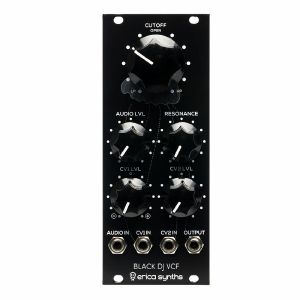
Features:
Combined LP and HP VCF
Manual and CV controlled cutoff frequency
Manually controlled resonance
CV attenuverter and attenuator
10HP
This product is available for pre-order at Juno, for shipping on the release date. You won’t be charged until the order is despatched.
We'll keep you informed of your order at every stage, and let you know if the release date changes.
If the price of the item drops before it's released, you will pay the lower price, but if it increases, you'll only pay the price you see today.
If you also include in-stock items on your order, they’ll be charged and shipped within 24 hours as usual.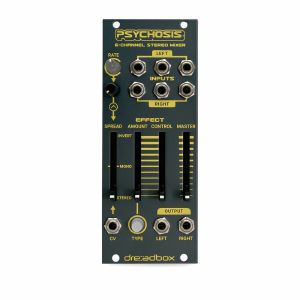
Single knob panning from Stereo to Mono to Inverse Stereo with CV control 1 x LFO for auto-panning and Leslie effect
4 x true stereo effects to choose from :
Reverb - Delay - Chorus (soft) - Chorus (hard)
current draw : 80mA @ +12V / 35mA @ -12V
10HP
This product is available for pre-order at Juno, for shipping on the release date. You won’t be charged until the order is despatched.
We'll keep you informed of your order at every stage, and let you know if the release date changes.
If the price of the item drops before it's released, you will pay the lower price, but if it increases, you'll only pay the price you see today.
If you also include in-stock items on your order, they’ll be charged and shipped within 24 hours as usual.
The high-efficiency PWM dimmers run at high frequency, ensuring flicker-free and noise-free operation. Additionally, extensive line filtering keeps your Eurorack power supply happy and clean.
Not limited to just manual control, both dimmers also feature control voltage (CV) inputs, turning the connected lamps from simple light sources to voltage controlled audio-visual spectacles.
While the use of the included BNC LED lamps is recommended in order to keep power consumption low, halogen lamps may be used as well. Provided your power supply is beefy enough, up to 6 W of power may be drawn from each output. This even makes it possible to drive 12 V LED strips, truly making your patches shine bright.
4 HP | +12: 150 mA, -12: 5 mA
This product is available for pre-order at Juno, for shipping on the release date. You won’t be charged until the order is despatched.
We'll keep you informed of your order at every stage, and let you know if the release date changes.
If the price of the item drops before it's released, you will pay the lower price, but if it increases, you'll only pay the price you see today.
If you also include in-stock items on your order, they’ll be charged and shipped within 24 hours as usual.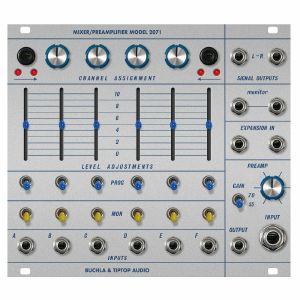
This product is available for pre-order at Juno, for shipping on the release date. You won’t be charged until the order is despatched.
We'll keep you informed of your order at every stage, and let you know if the release date changes.
If the price of the item drops before it's released, you will pay the lower price, but if it increases, you'll only pay the price you see today.
If you also include in-stock items on your order, they’ll be charged and shipped within 24 hours as usual.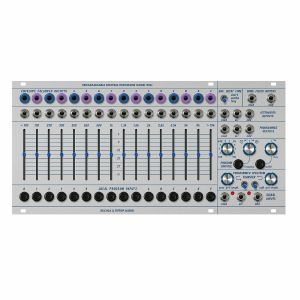
This product is available for pre-order at Juno, for shipping on the release date. You won’t be charged until the order is despatched.
We'll keep you informed of your order at every stage, and let you know if the release date changes.
If the price of the item drops before it's released, you will pay the lower price, but if it increases, you'll only pay the price you see today.
If you also include in-stock items on your order, they’ll be charged and shipped within 24 hours as usual.
1 wide-band FM/AM/SW radio with LFO modulated tuner knob
2 self-oscillating analogue 4-pole low-pass filters (clones of CEM3320, the chip used in the Prophet 5) with resonance and LFO modulation
4 seconds of stereo digital delay with feedback, sync, tone control and panning with LFO modulation
1 LFO with 16 different "bendable" waveforms with polarity and multiplier (up to 200Hz in quad-wave mode)
1 sync unit to lock the LFO to: 1-audio click track, 2-analog clock, 3-tap tempo
2 analogue 2-pole high-pass filters
2 external inputs with overdrive
Specifications
Audio outputs (stereo)
Typical Voltage: 1 volt
Maximum Voltage: 4.2 volts (peak-to-peak)
Nominal Output Impedance: 500 Ohms
Headphones output (STEREO)
40 mW into 32 Ohms
SNR > 90 dB
Audio inputs (Stereo + click track IN)
Voltage : +10 millivolts (min); +10 volts (max.)
Nominal Input Impedance: 4,700 Ohms
Clock Pulse IN/OUT
Typical voltage: 0 to +5 volts square pulse
The LFO syncs on the negative-going pulse
LP Cutoff CV Input
Range: -5 to +5 volts
Nominal Input Impedance: 12,000 Ohms
LFO Output
Range: -5 to +5 volts
Nominal Output Impedance: 8,000 Ohms
Power supply
External supply: 100-240 volts; 50/60 Hz
Output: 12 VDC
< 12 Watt nominal consumption
Dimensions
Width: 420 mm
Depth: 260 mm
Height: 90 mm
Net Weight: 2 kg
Temperature
Storage Temperature: 2 - 60 C
Nominal Operating Temperature: 10 - 35 C
Operational Temperature: 10 - 50 C
This product is available for pre-order at Juno, for shipping on the release date. You won’t be charged until the order is despatched.
We'll keep you informed of your order at every stage, and let you know if the release date changes.
If the price of the item drops before it's released, you will pay the lower price, but if it increases, you'll only pay the price you see today.
If you also include in-stock items on your order, they’ll be charged and shipped within 24 hours as usual.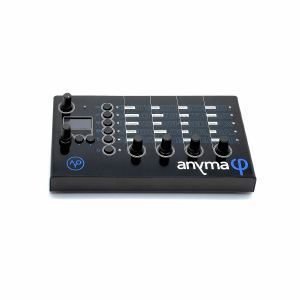
Discover Anyma Phi, the essential physical modelling synthesizer. Your portal to creating new sound universes inspired from the real world, where objects collide, vibrate, and resonate.
The best of both worlds
Anyma Phi blends the classic ingredients of electronic music, like oscillators and filters, with physical modelling technology, allowing it to simulate acoustic sound sources, such as strings or reeds, as well as resonating structures, like wood, glass, or metal.
Create Unique Sounds; sound design for all
The matrix provides a quick and easy way to explore your sounds by following a physical metaphor, with four macros for each of the five stages of sound generation: Excite, Vibrate, Resonate, Global, and Animate.
Infinite Possibilities; a semi-modular powerhouse
Beyond the matrix lies an insanely powerful semi-modular synthesis engine where you can harness a wide variety of oscillators and effects, and control them effortlessly using an impressive modulator system. Going so deep into sound design has never been easier before with such a small box!
Anyma Phi Editor; standalone, but well-connected?
The Anyma Phi can hold up to 200 patches, and everything you need to create them is right on the machine. You can also benefit from the large screen of your computer (PC or Mac) to edit, manage and share patches even more easily, in a streamlined environment that displays all the synth modules at once and their interactions in real time. Learn more about the Anyma Phi's Updates and Downloads.
MIDI Controller; In tune with its environment
With its small form factor, it can sit on your keyboard, or anywhere on your desk. You can control it using any MIDI controller, keyboard or sequencer, with first-class support for wind controllers, like Sylphyo. And it also shines with World and microtonal music*!
Just Tap and Scratch; the world is your oyster
With its stereo input, you can also use the Anyma Phi as a versatile effects processor for your other gear, or use any external sound to excite its resonators and other physical models. And you don't even need a mic to get interesting sounds: just tap and scratch directly on the case of the Anyma!
Technical specifications:
Hybrid monophonic synthesizer, with physical modelling components
Memory: 200 patches
Stereo audio outputs:
L-R 1/4" mono line jack outputs
1/4" stereo headphone jack output
Stereo audio inputs:
1/4" stereo jack audio input
Internal piezoelectric mic when external input unplugged
MIDI inputs and outputs via USB and DIN ports
Powerful digital semi-modular synthesizer engine:
3 oscillator slots (more than 40 types, including wind/string physical models, modal resonators, virtual analogue and digital algorithms)
5 effect slots (more than 30 types, including resonators, granular processors, and FM operators) along 2 serial buses (Main, Aux) + 1 mono reverb
16 modulator slots (more than 40 types, including envelope generators, LFO, curves, interpolators, slew limiters, sequencers, physical and algorithmic processes, etc.)
32 mapping slots (virtual patch cords), each allowing to control any synth parameter (including another mapping) using a modulator or a controller input, with sidechain input and min/max/curve/smoothing
Responsive to pitch, pitch-bend, velocity, breath control/expression, as well as 4 other controller inputs (with MIDI learn)
External MIDI CC control for the matrix and the entire patch (via NRPN)
World-class microtonal support: up to 8 custom tunings, 50 onboard presets, onboard editor, MTS import/export
Built-in arpeggiator: 15 patterns, internal/external MIDI clock sync, custom triggers
Support for up to 3-note paraphony when building a patch
External audio processors
Automatic random patch generation (optional)
Free software editor/librarian (Mac/PC)
225 x 120 x 70 mm (8.9 x 4.7 x 2.8") and 900 gr (2 lbs)
Included: Anyma Phi, 5V PSU and USB cable
Designed and made in France
This product is available for pre-order at Juno, for shipping on the release date. You won’t be charged until the order is despatched.
We'll keep you informed of your order at every stage, and let you know if the release date changes.
If the price of the item drops before it's released, you will pay the lower price, but if it increases, you'll only pay the price you see today.
If you also include in-stock items on your order, they’ll be charged and shipped within 24 hours as usual.
It is a completely original circuit inspired by the singular nature of Vactrols and their fluid and natural character.
The Filter section provides the three fundamental filter types: Lowpass, Bandpass and Highpass.
A Resonance knob with voltage control input is available for improved modulation flexibility. The feedback knob interacts with the Resonance path, tempering it from creamy resonance to wacky self-oscillation.
Filter and VCA run in parallel, both are controlled by the Freq/Amp knob and it's associated voltage-control input. The combination of both signals can be crossfaded with a dedicated knob.
The Freq/Amp is also controlled with direct touch control on the panel via the 3 lines below the knob.
The filter frequency control can be inverted by the Inv Freq switch, providing the possibility to change the filter direction. This feature allows the filter to "close" when the VCA is "opening" or the other way around.
The Ping input allows to generate the well known vactrol filter percussive sounds if a gate or trigger signal is provided. The Ping frequency if controlled by the Freq/Amp knob, ranging from low kicks drums to high pitch bongos.
There is also a Drive knob to take care of your saturation needs. The Overdrive range is wide, from soft textural clipping to heavy distortion.
All voltage controlled inputs have an attenuator-inverter knob.
Features:
Vatrol based 12dB multi-mode Voltage Controlled Filter: Lowpass, Bandpass and Highpass.
Vactrol Based Voltage Controlled Amplifier.
Crossfade between VCF and VCA section.
Voltage controlled Resonance.
Ping Input for percussive sounds generation.
Cutoff Frequency polarity inversion switch. Doesn't change VCA polarity
Overdrive and Feedback controls.
Attenuator/inverter knobs on all voltage controlled inputs
Touch control over Frequency and Amplitude.
Specs:
Width: 10HP
Depth: 33mm
Power consumption: 55mA +12 / 55mA -12
Eurorack Format
Doepfer power connection
This product is available for pre-order at Juno, for shipping on the release date. You won’t be charged until the order is despatched.
We'll keep you informed of your order at every stage, and let you know if the release date changes.
If the price of the item drops before it's released, you will pay the lower price, but if it increases, you'll only pay the price you see today.
If you also include in-stock items on your order, they’ll be charged and shipped within 24 hours as usual.Help & Information
OrderingOrdering ProblemsFAQContact Us (Customers)Contact Us (Suppliers)About JunoJuno DailyNew This WeekDJ & Studio StoreTagsFeedbackPrivacy PolicyReturns & refundsTerms and ConditionsFinanceJuno Vinyl DistributionJuno Marketing and PR departmentPromote your label / releasesDepartments
Juno DailyComing soonGift certificatesClassicsCreate a chartRepressesFull label listTop LabelsMy Juno
My artists and labelsMy Back-In-Stock AlertsMy AccountMy WishlistMy ChartsMy New Release E-mailsMy Order HistoryMy Coming Soon Alerts100% Secure Shopping
DJ Mag Best Of British
Best Music Store: 5 time winners
© 1996 - 2023 Juno Records
All image and audio content is used by permission of the copyright holders or their agents, and/or according to fair dealing as per the UK Copyright, Designs and Patents Act 1988.


